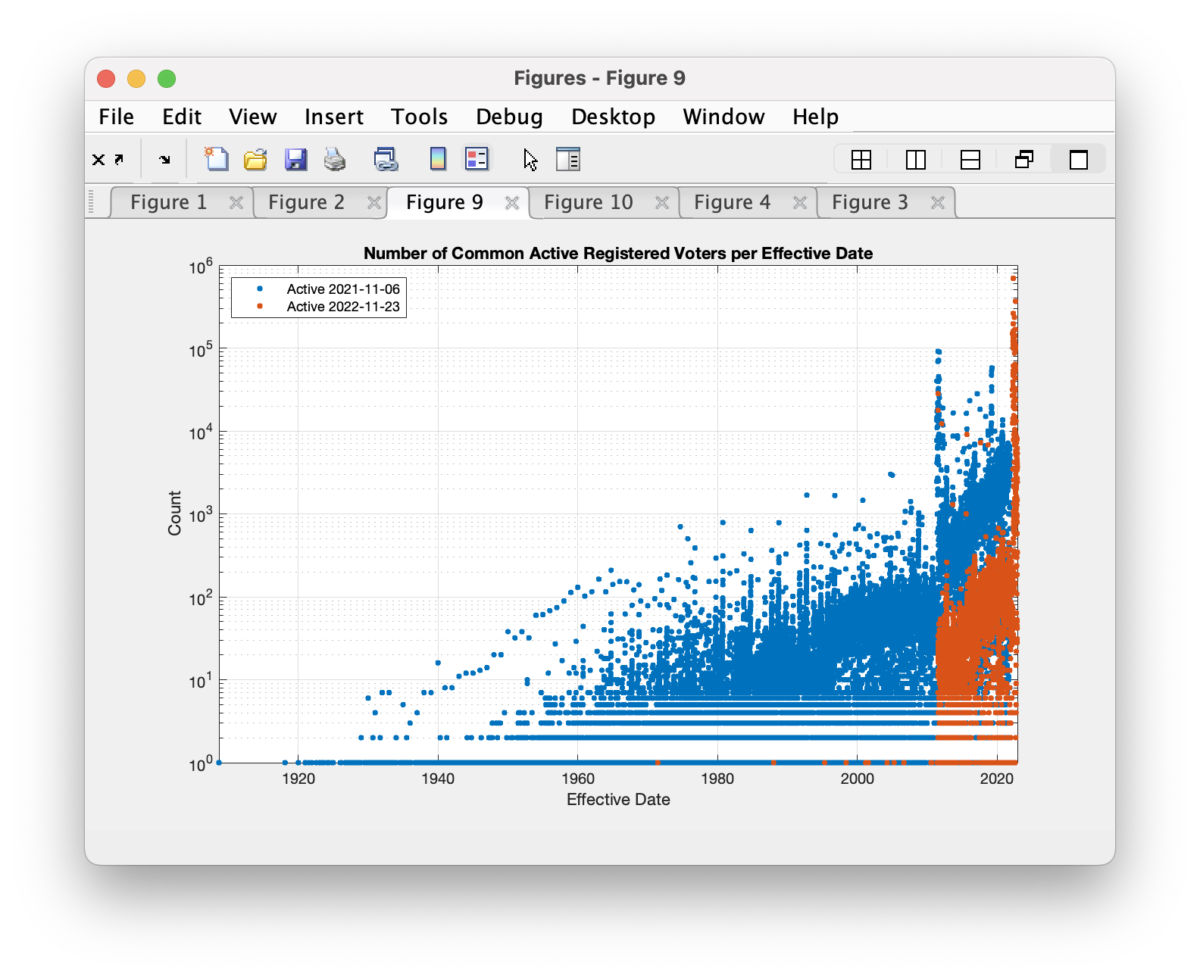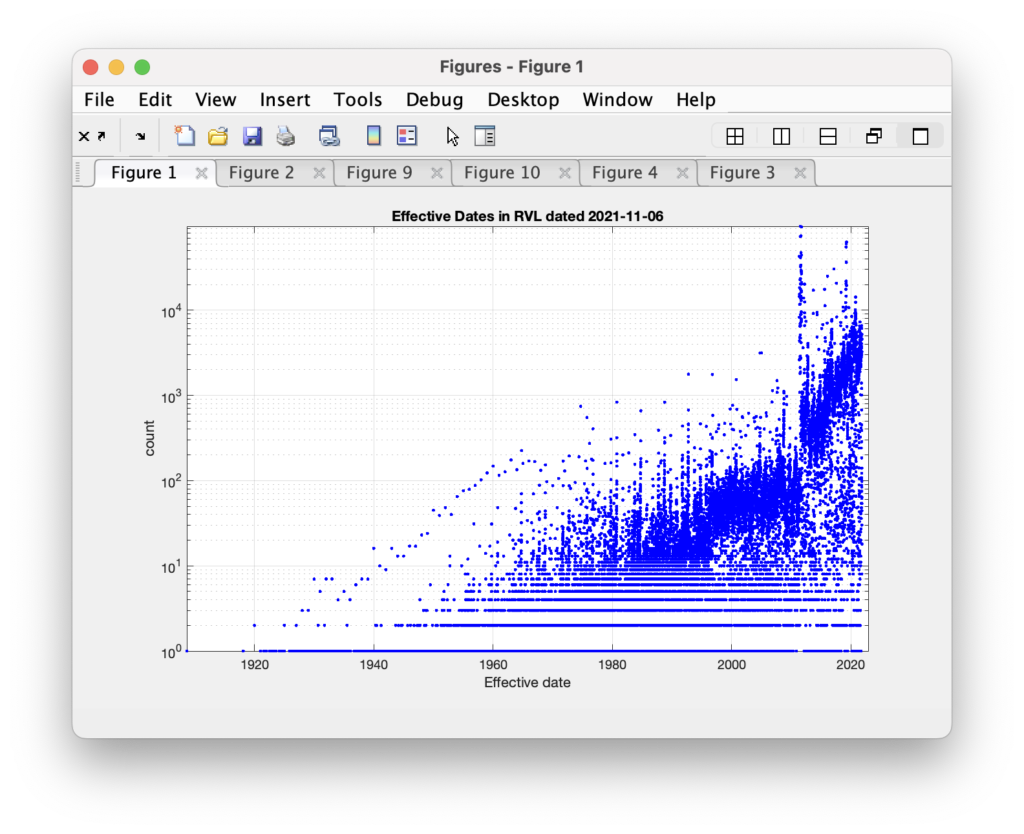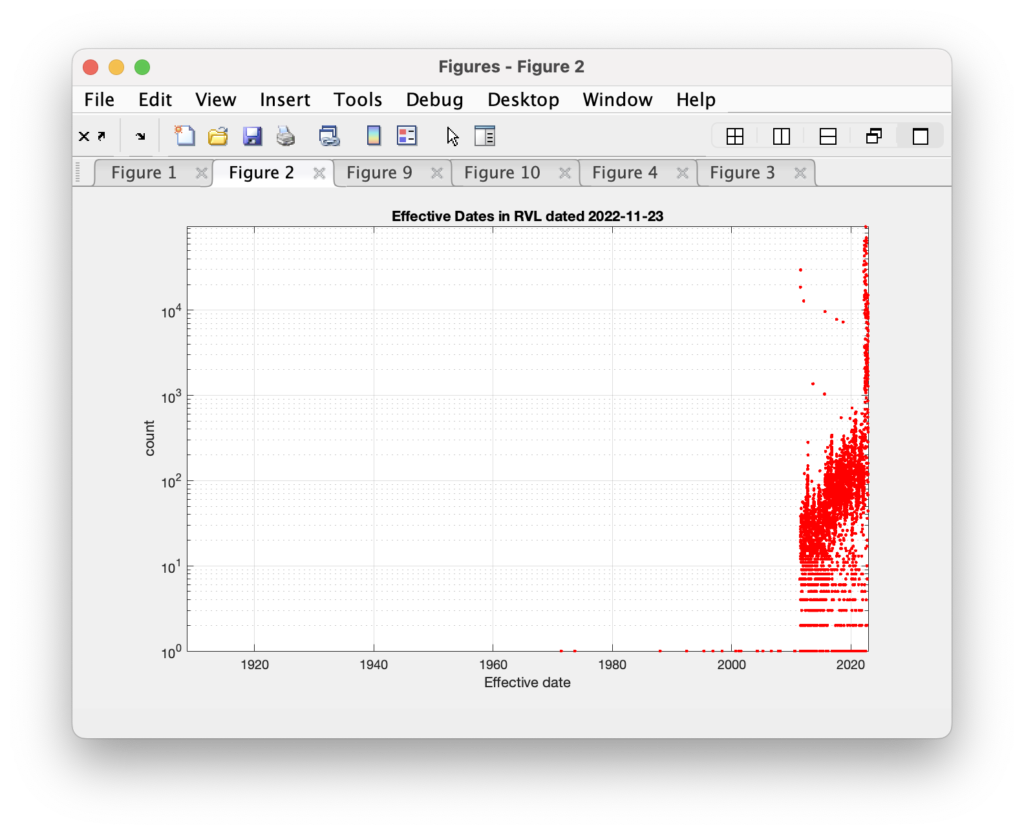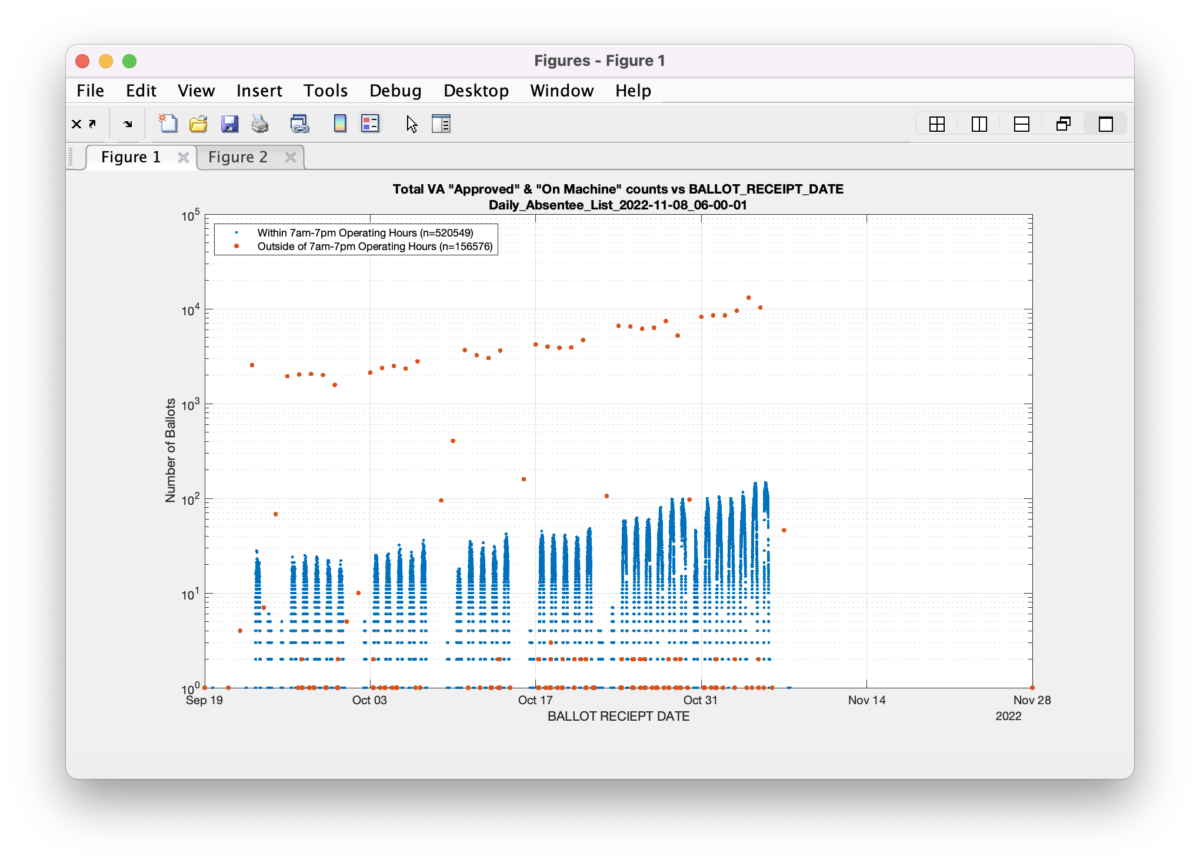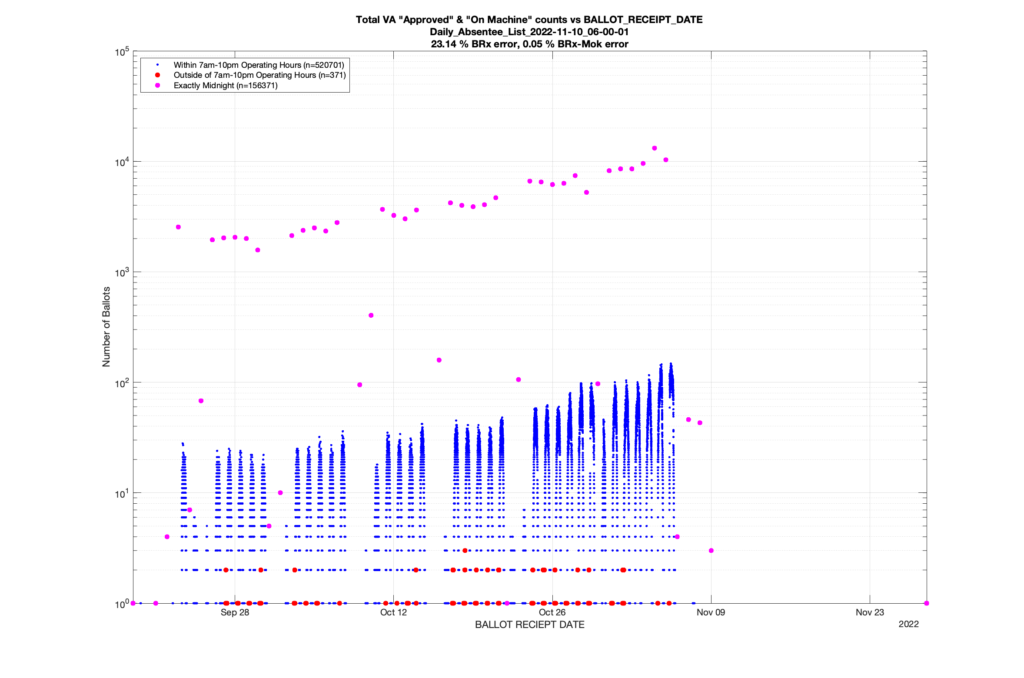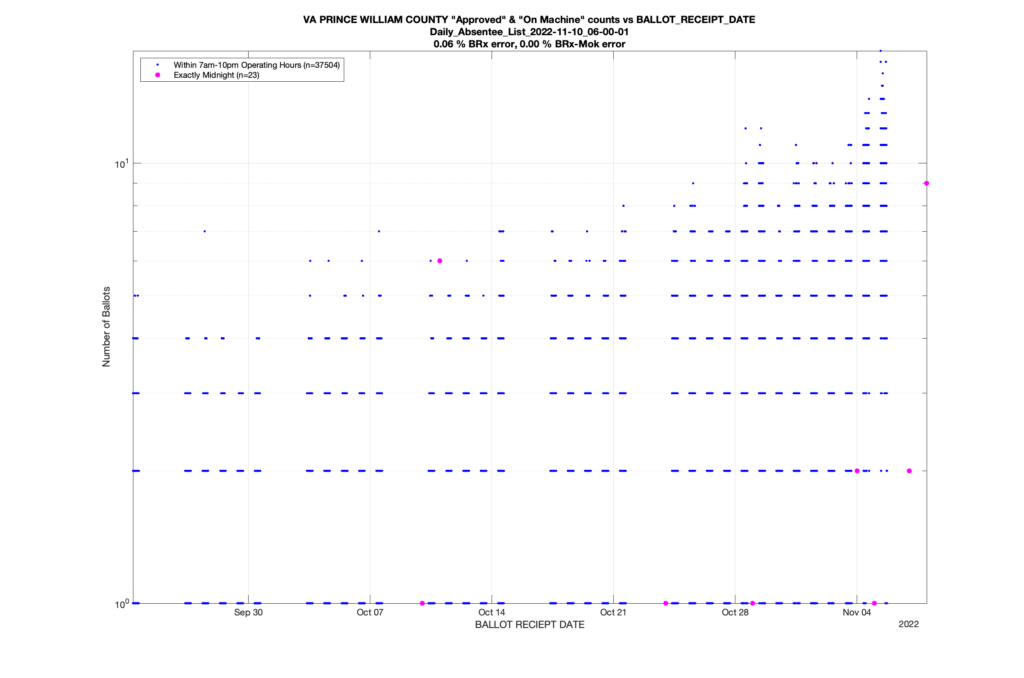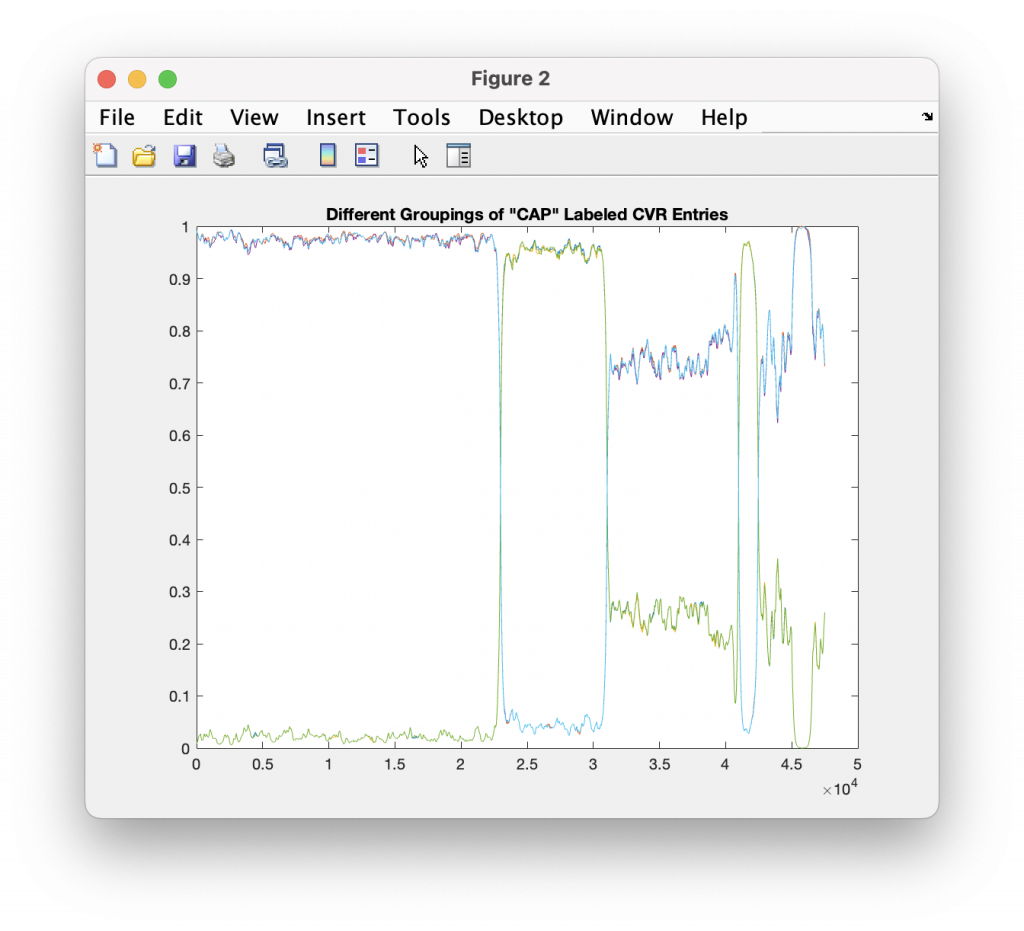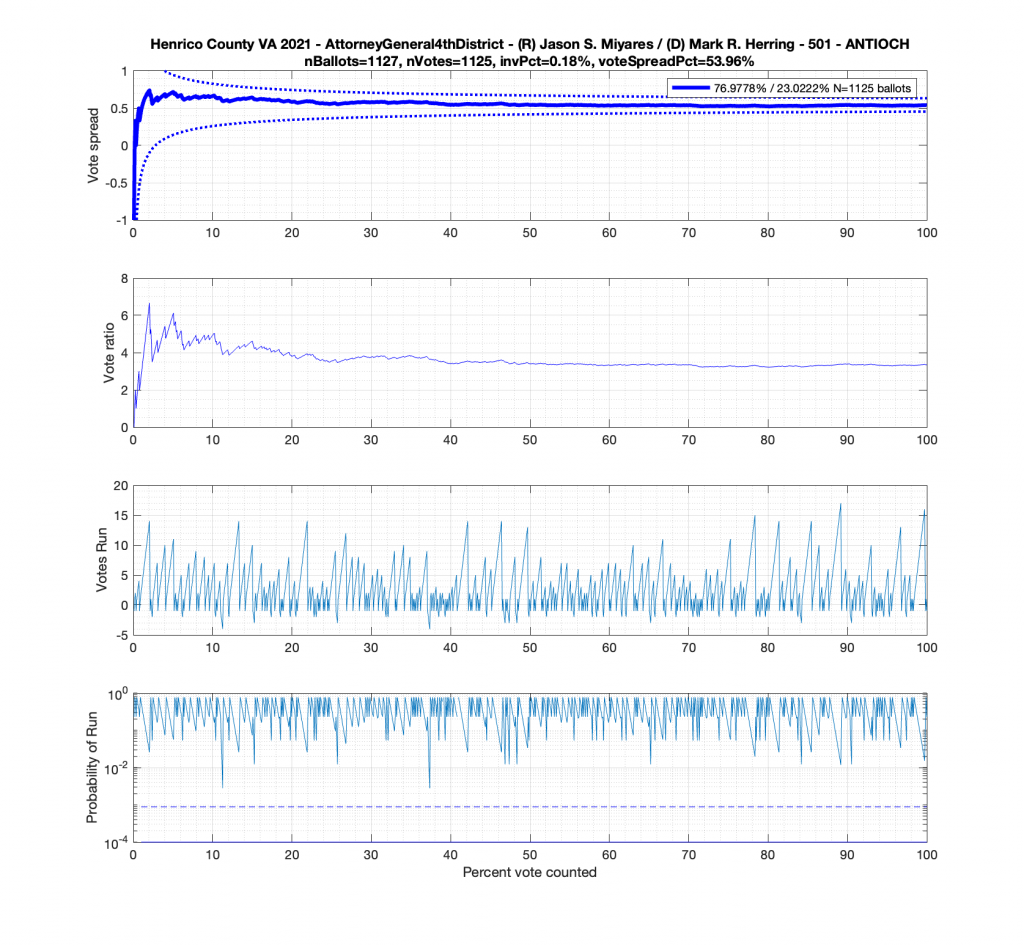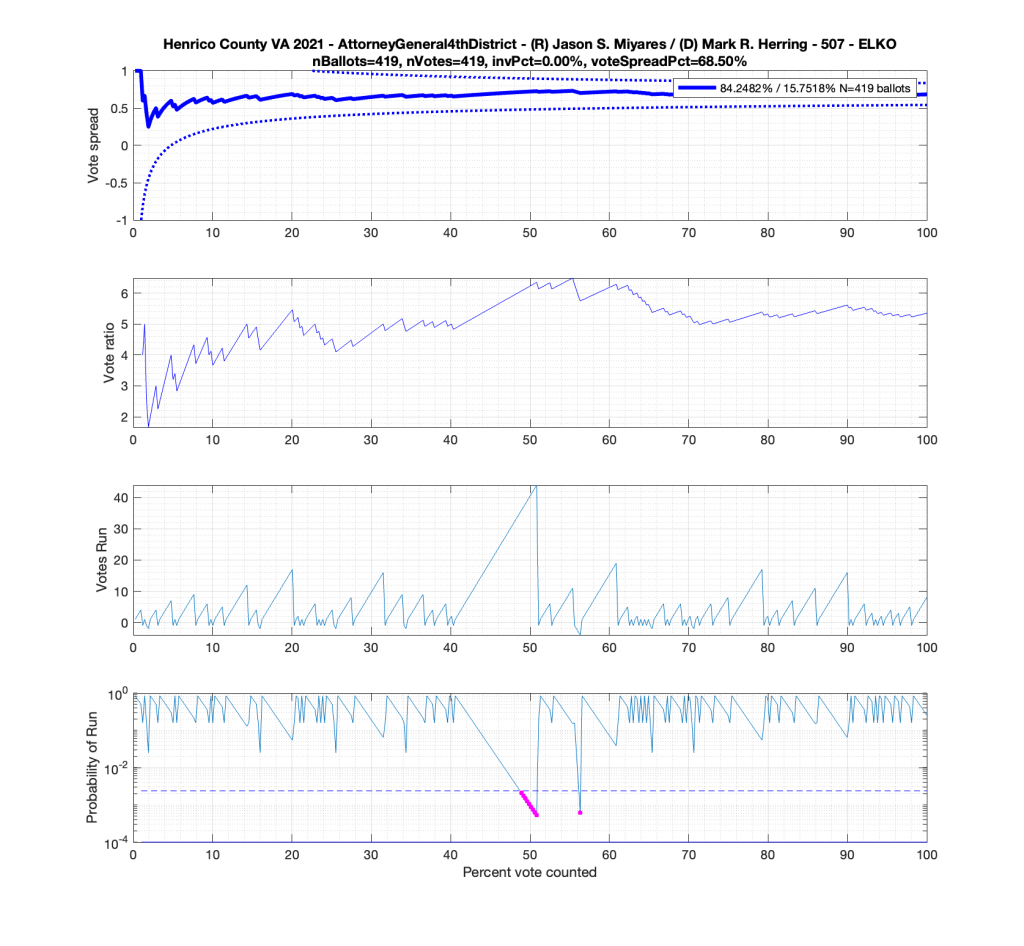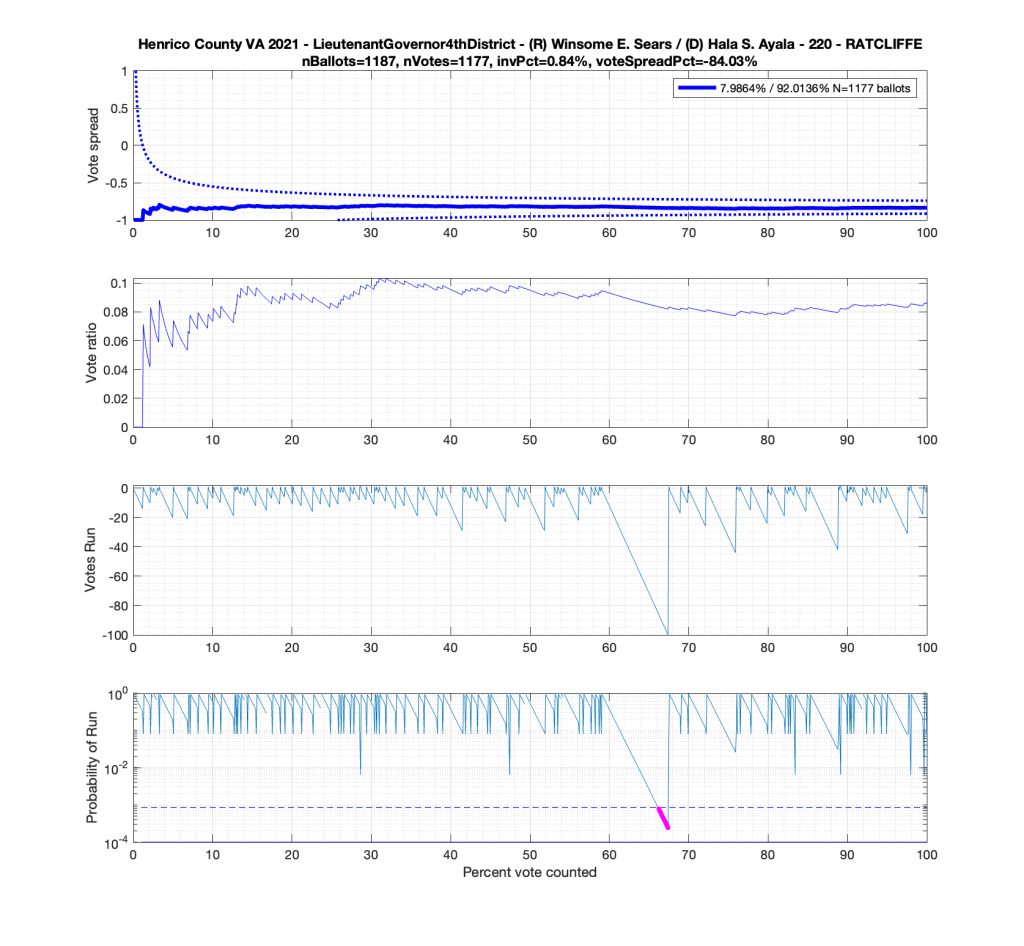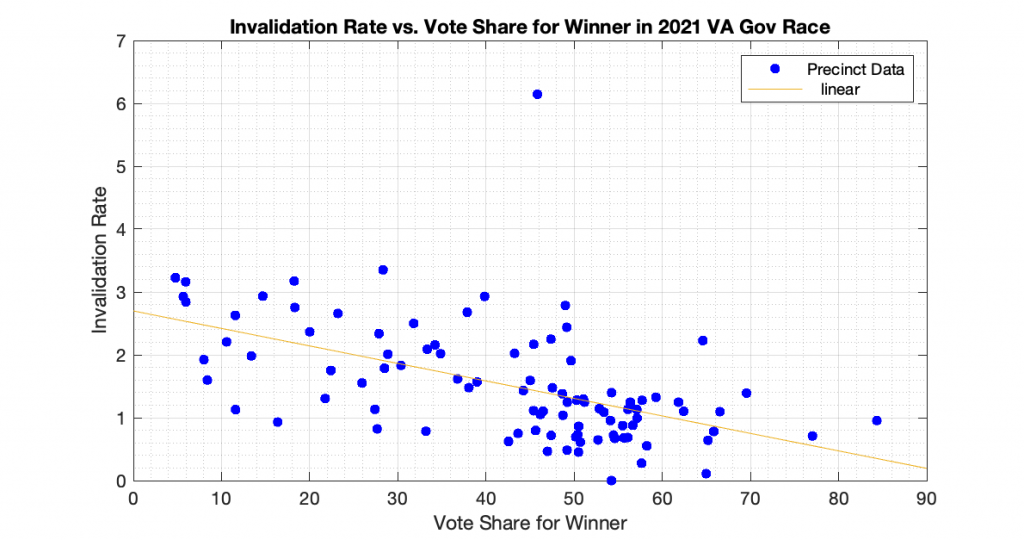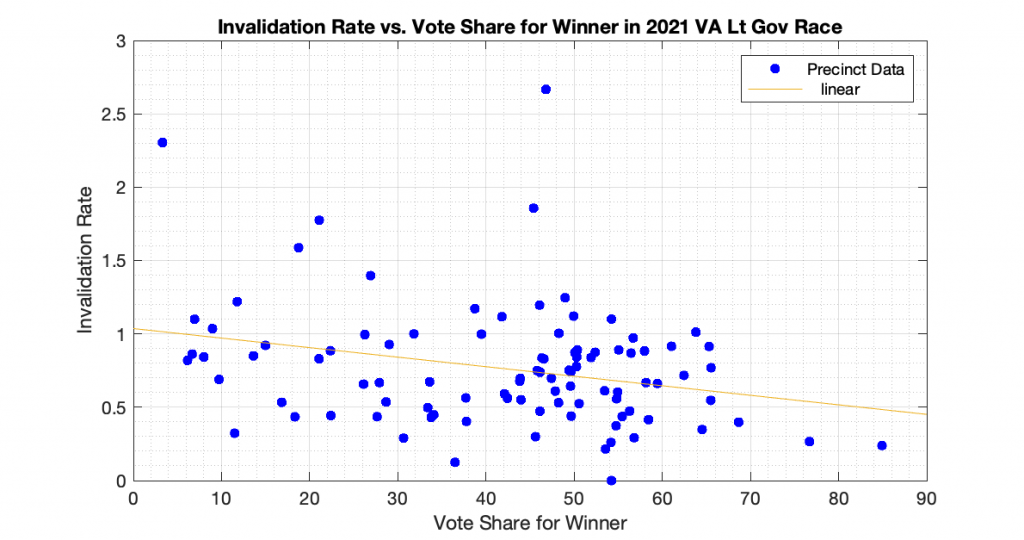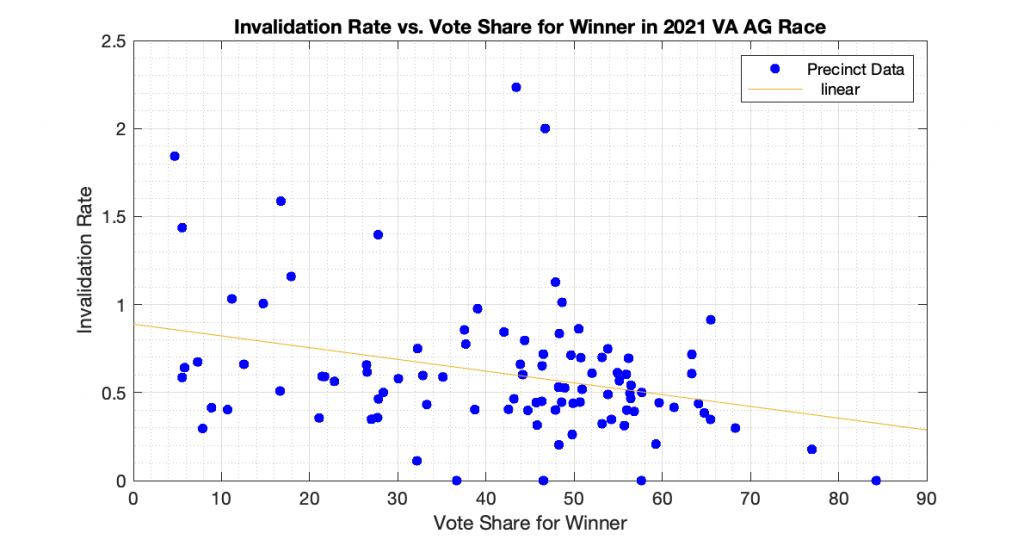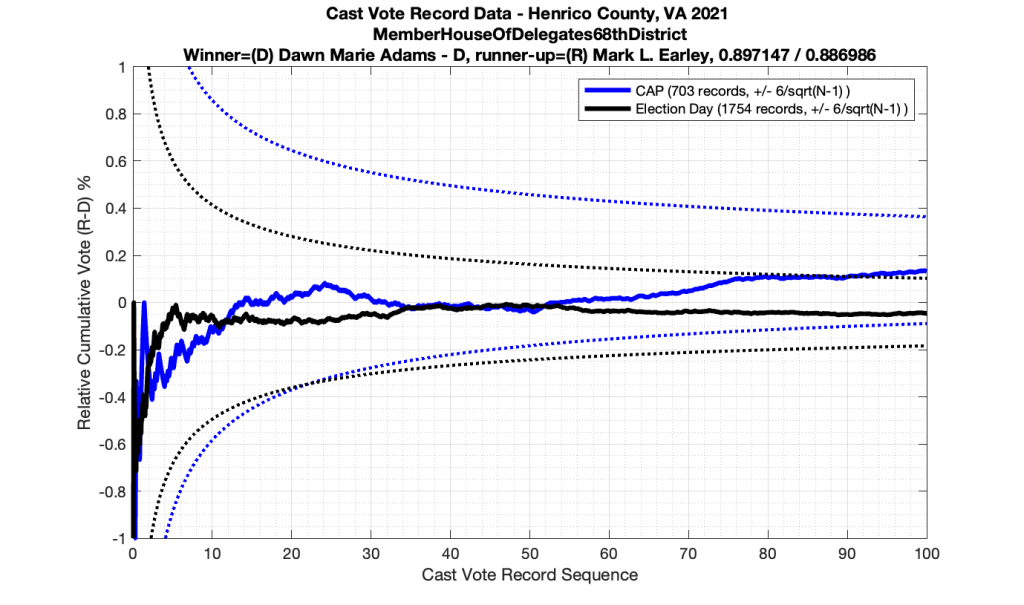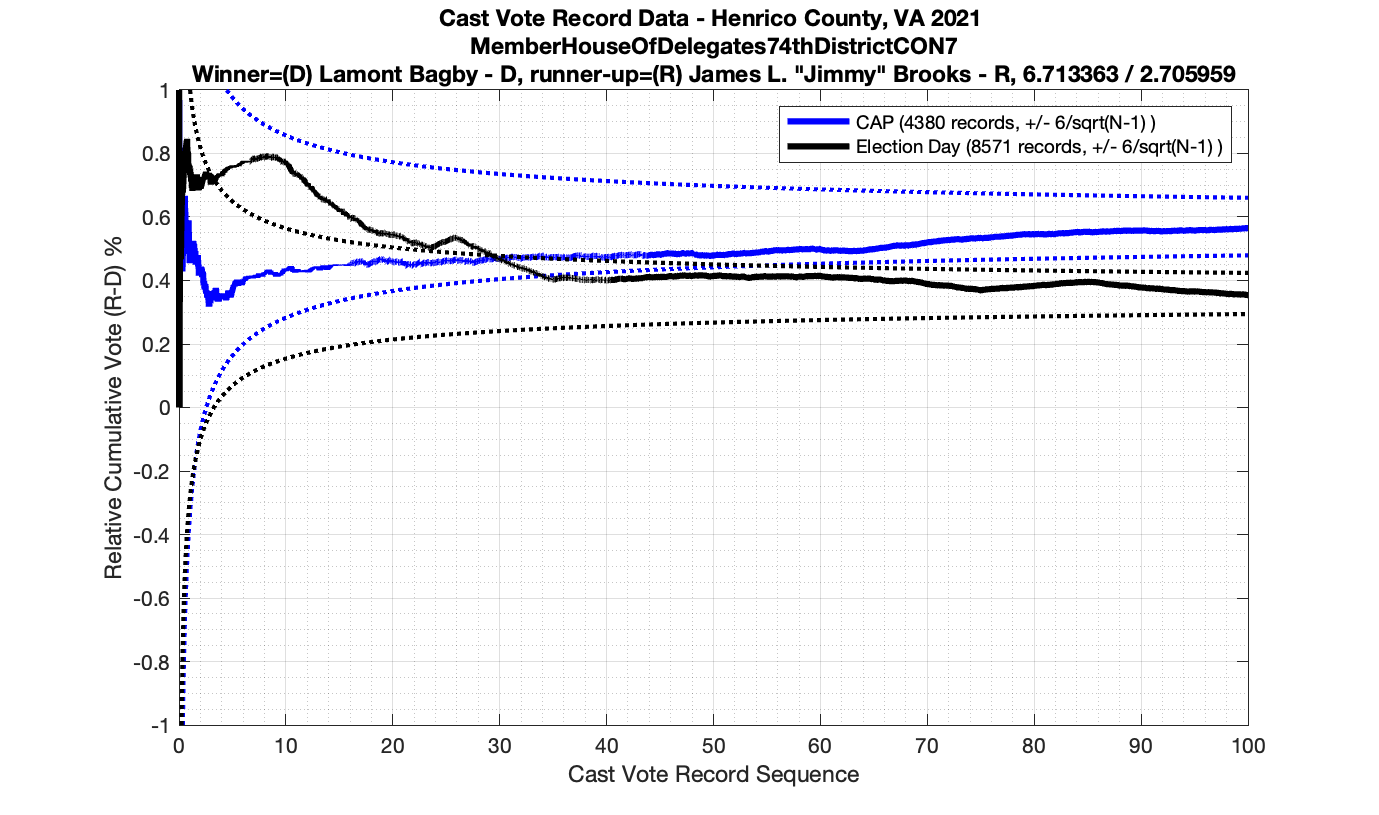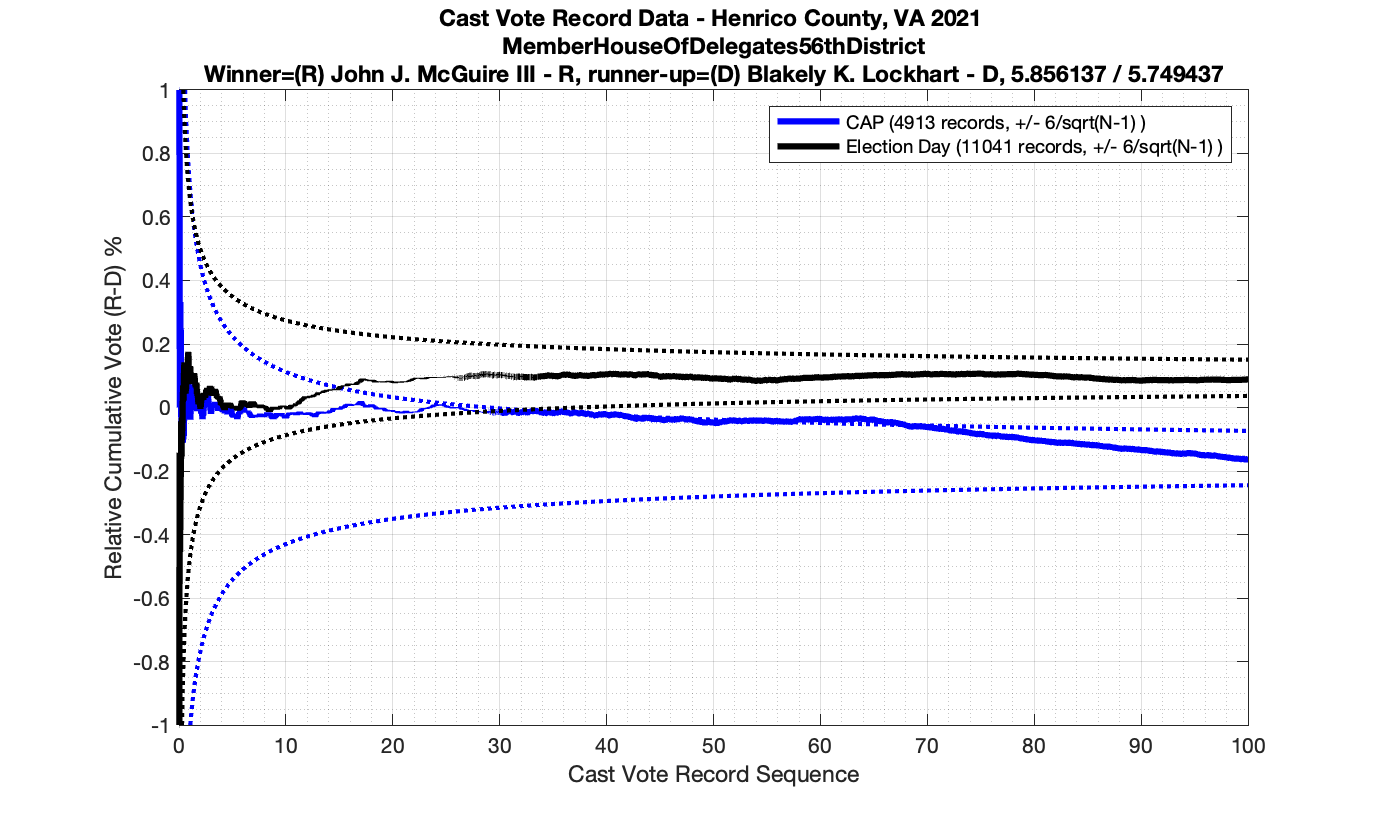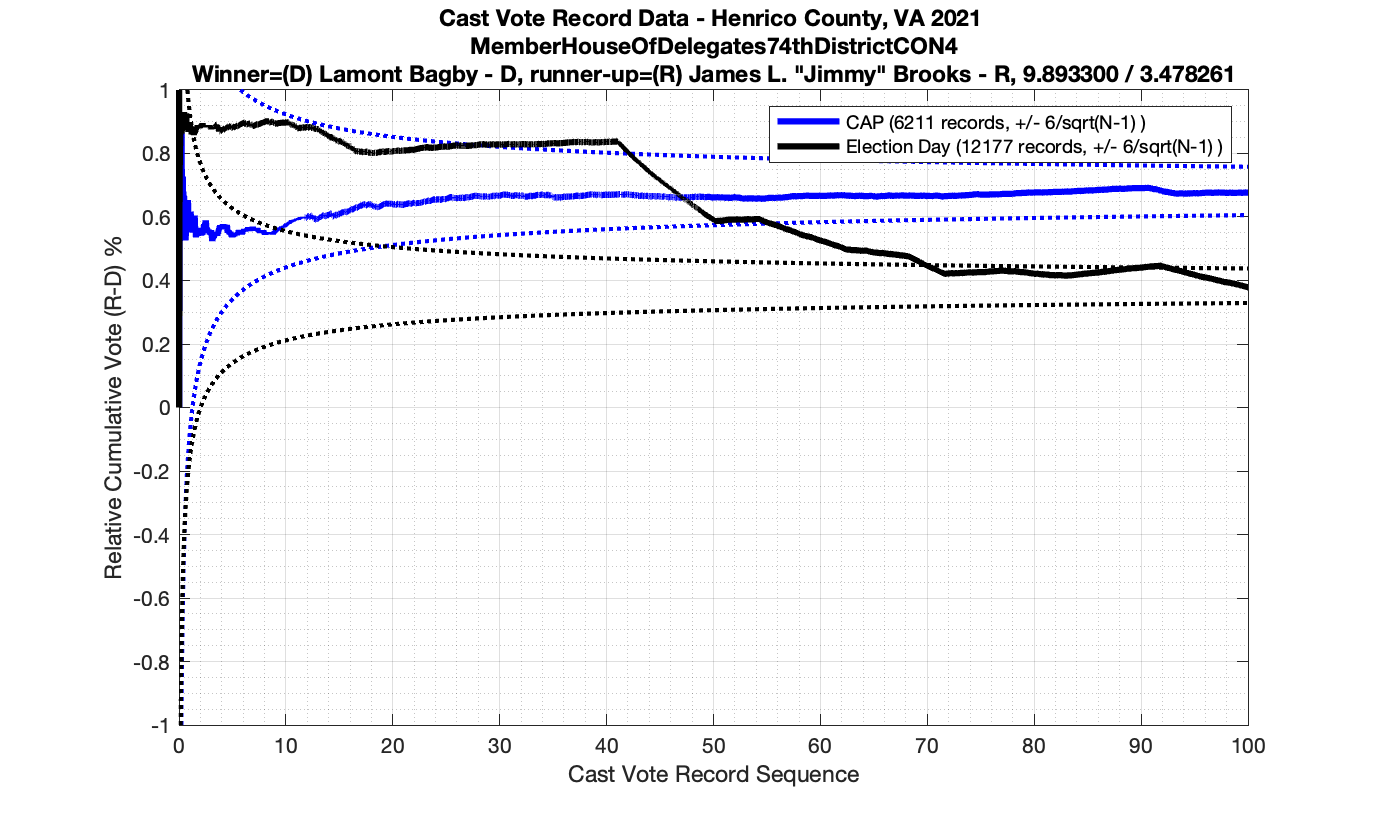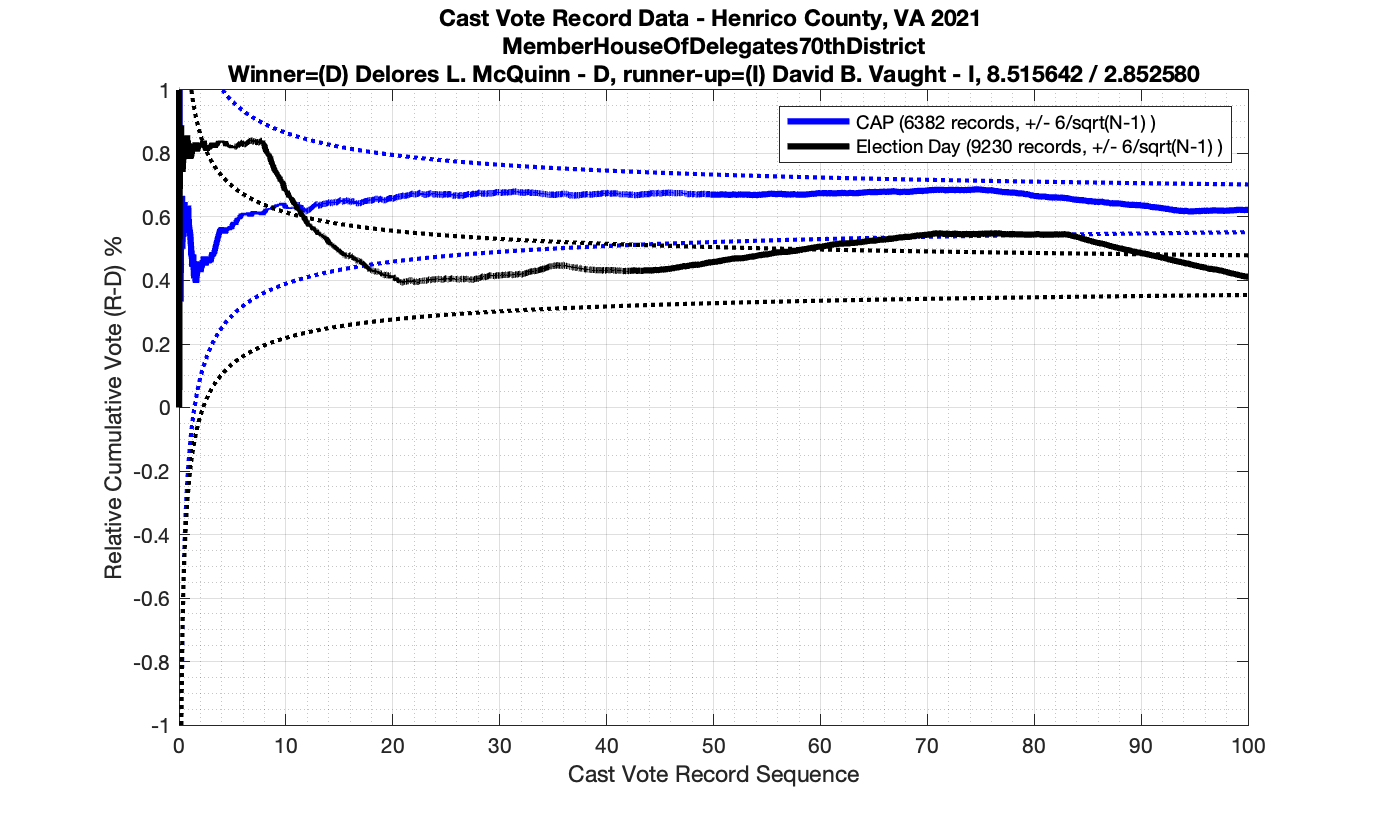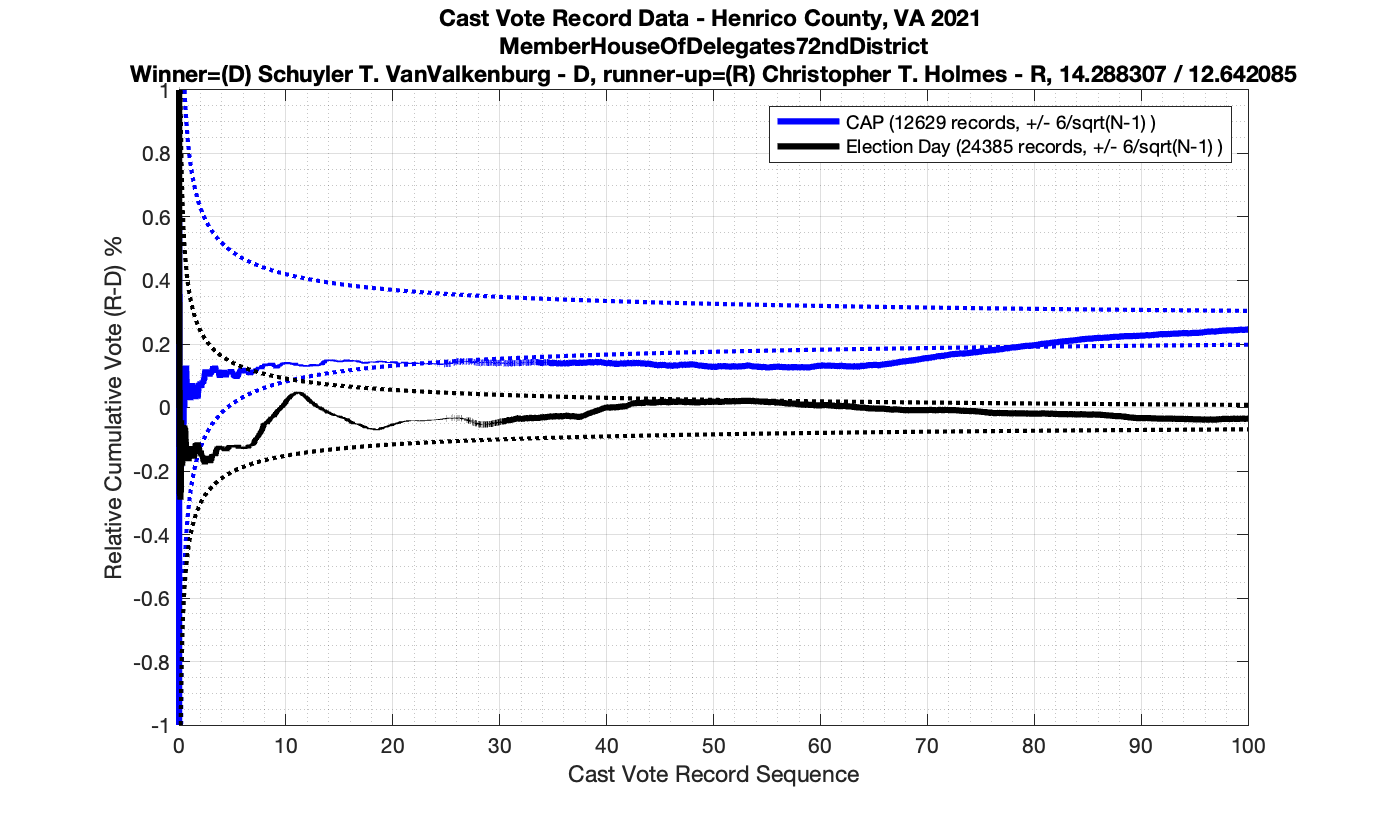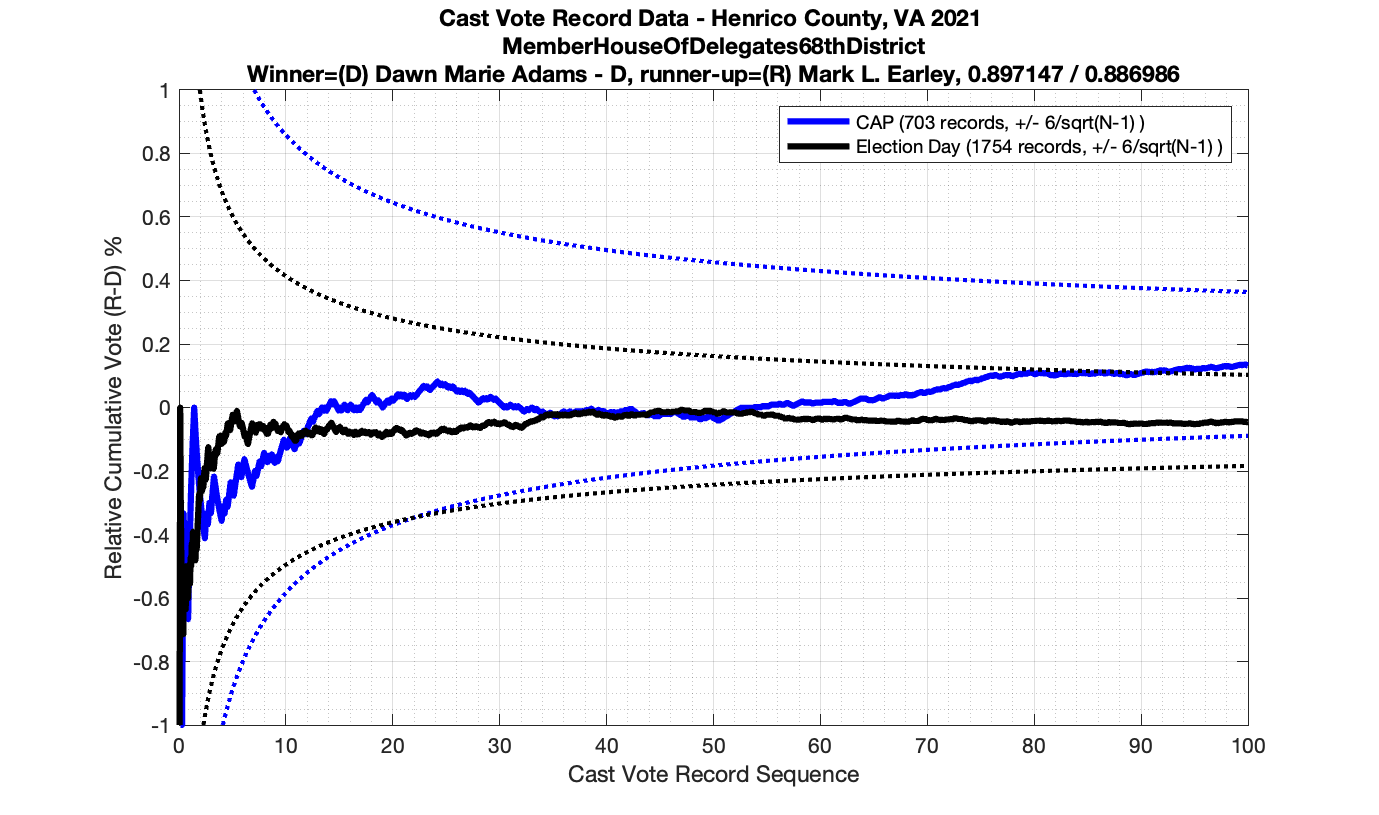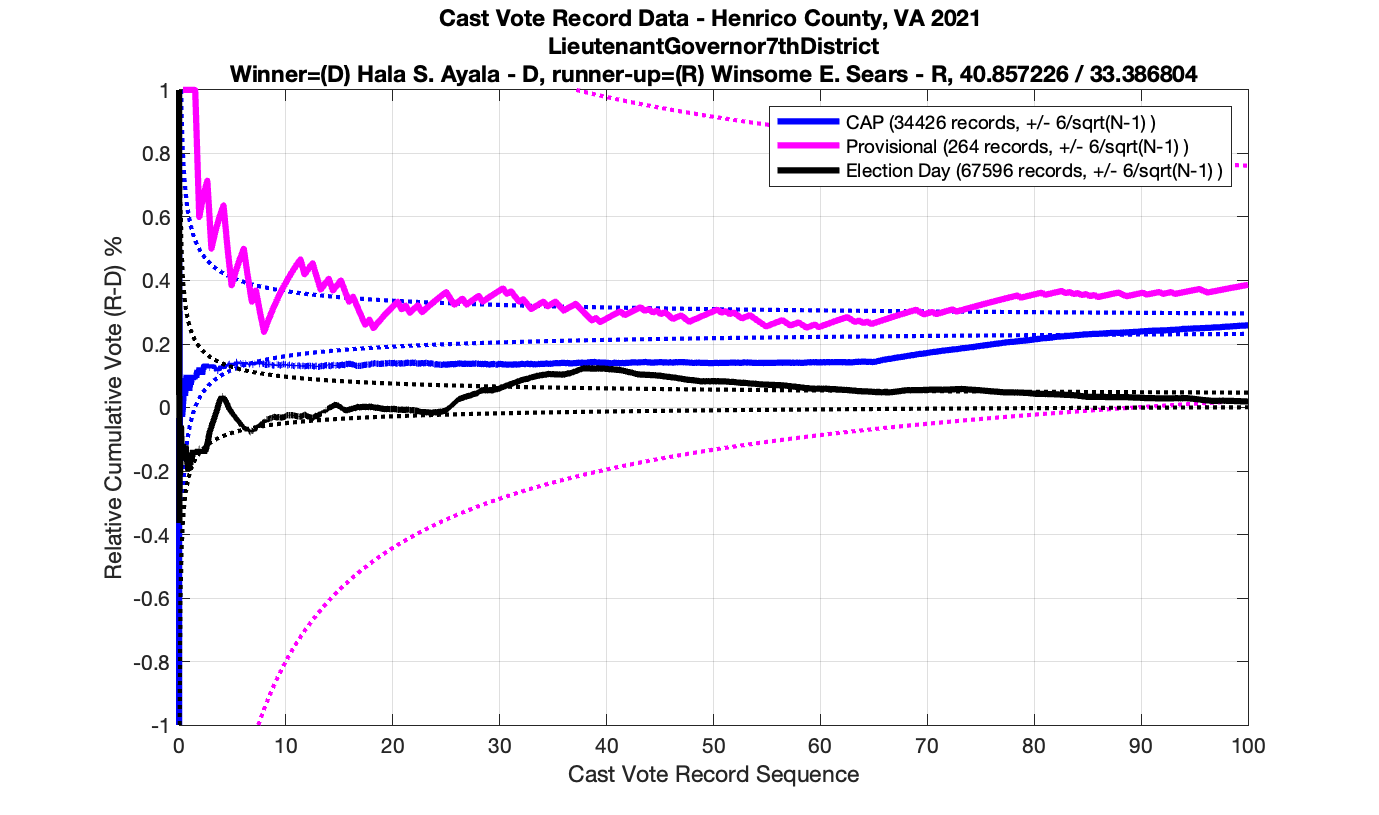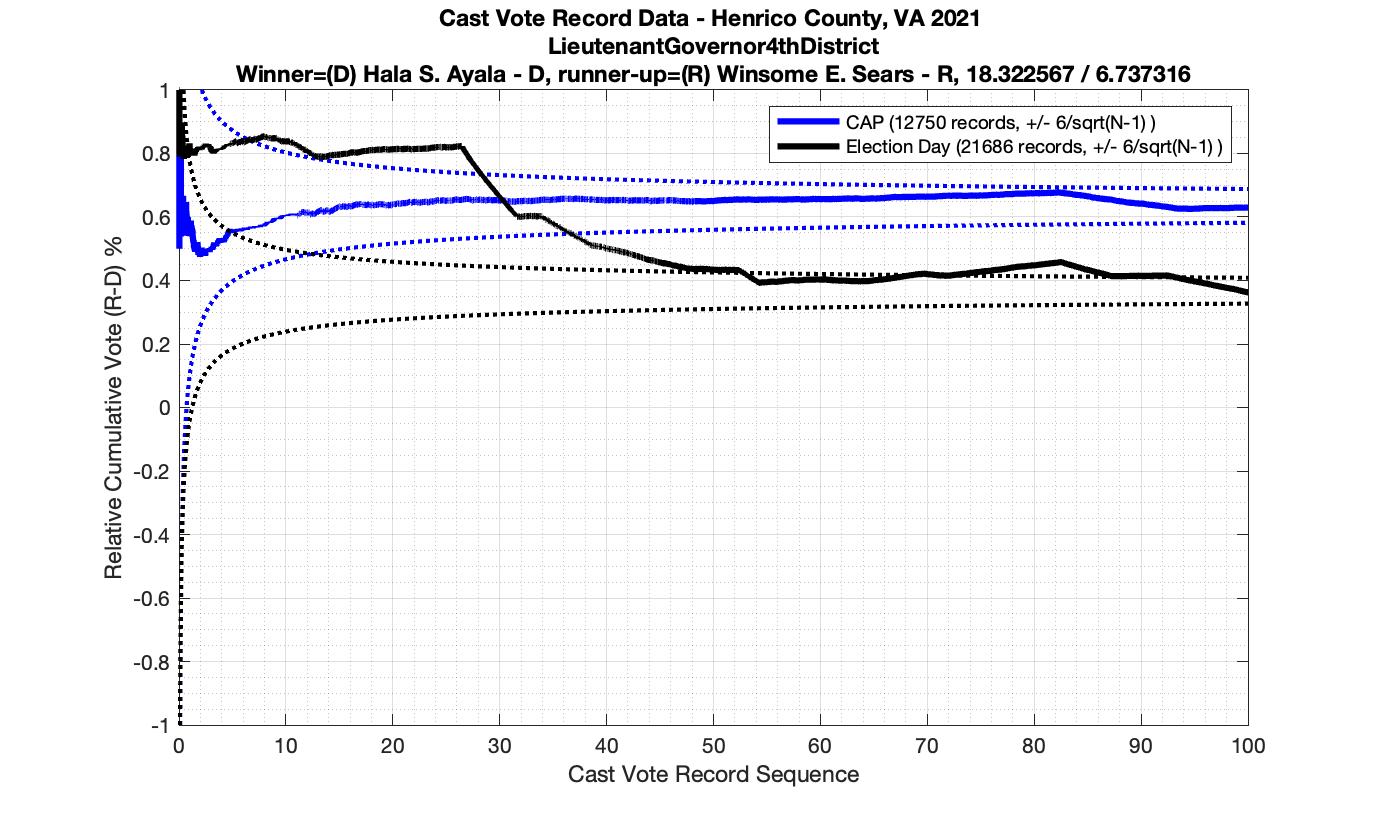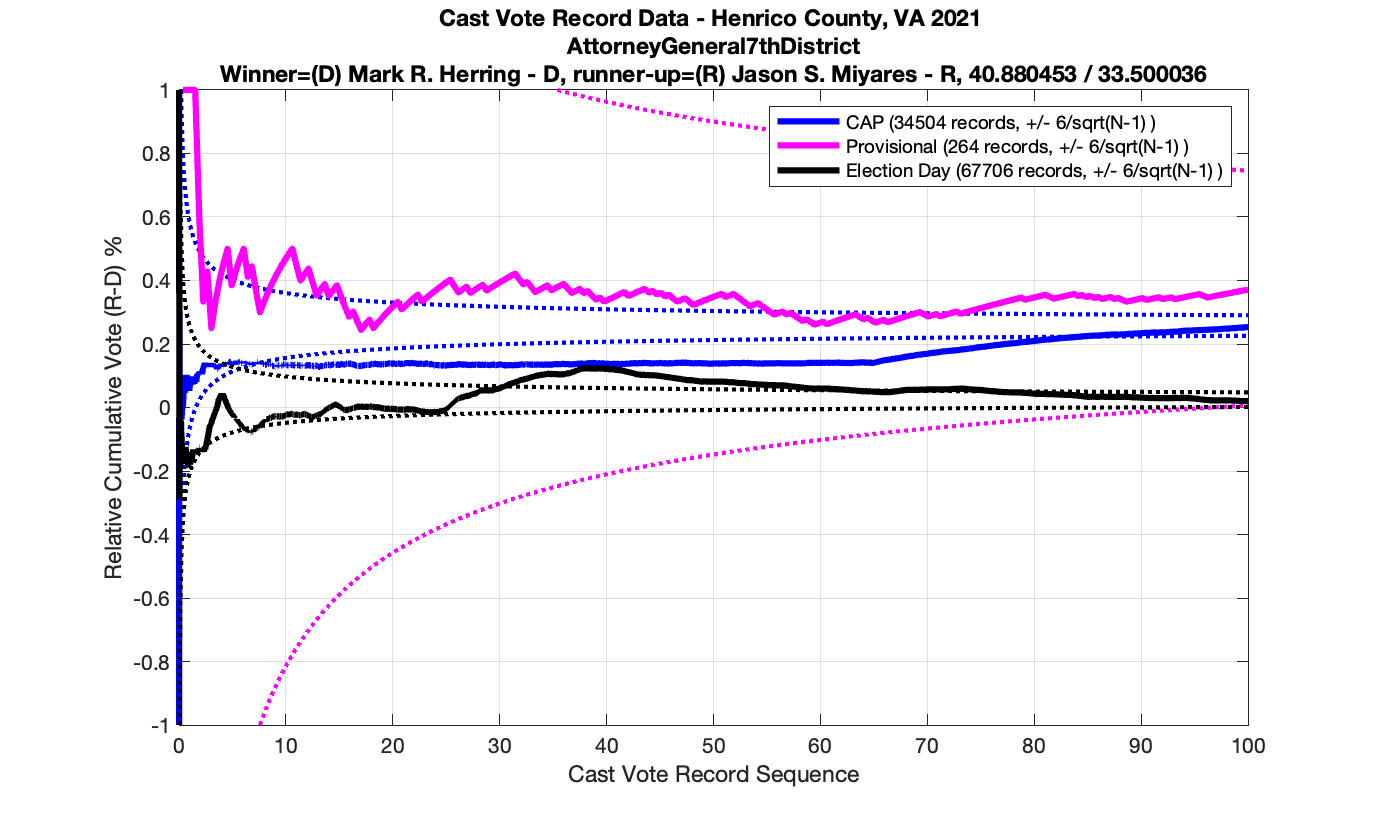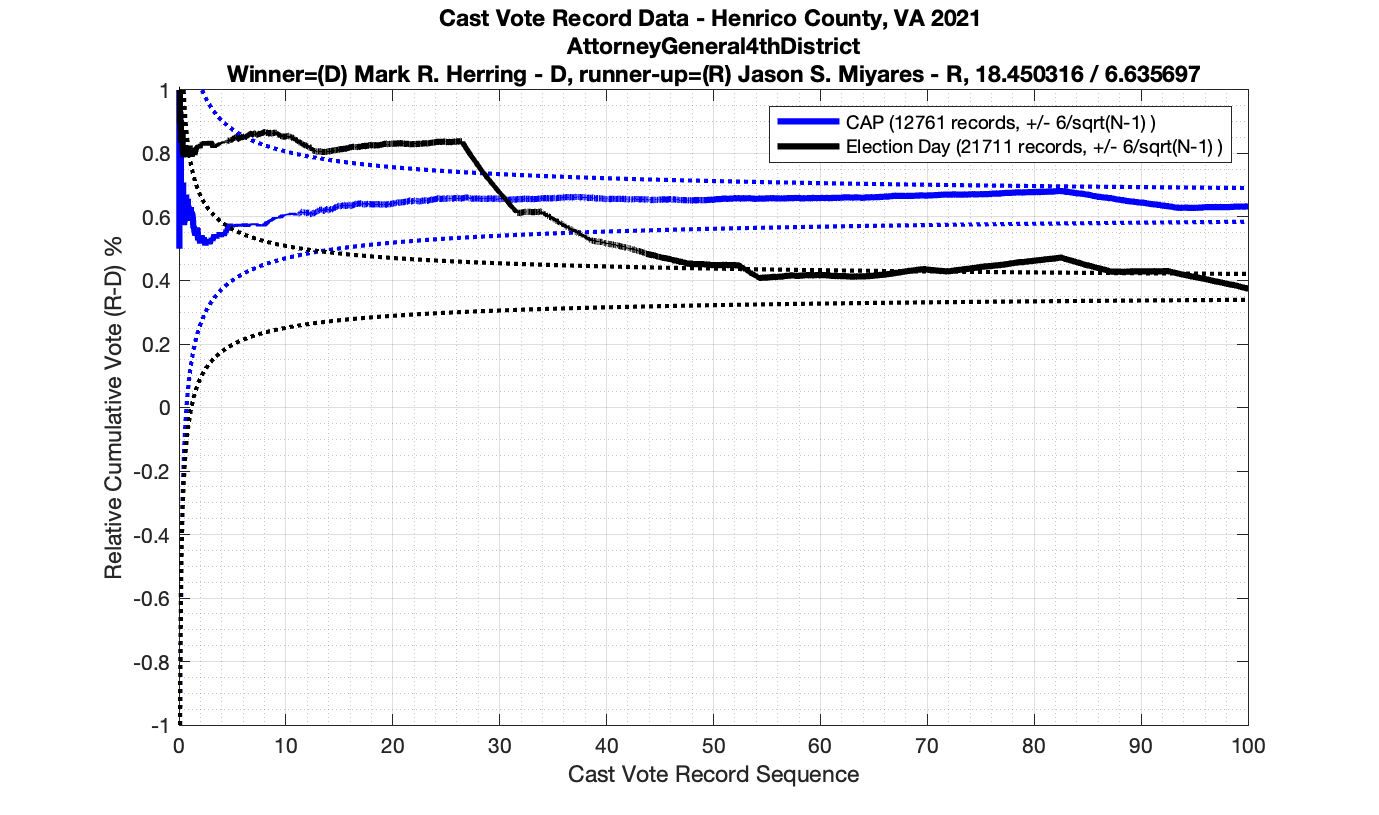Edited on 2022-12-15 for typo corrections, addition of Congressional District breakdown, and added commentary section.
BLUF (Bottom Line Up Front):
There were 15,419 ballots cast during early voting in the VA 2022 General Election where the voters’ registered address on record were flagged as “Invalid” by a National Change of Address (NCOA) database check. If we include addresses that were identified as 90-day Vacant the total rises to 17,244. Plotting the distribution of these based on the ZIP+4 identified by the NCOA check shows a disproportionate high amount of issues in the Eastern shore of VA.
A certified commercial provider of NCOA data verification was used to facilitate this analysis on raw data obtained from the VA Dept of Elections (“ELECT”). It is not technically possible to obtain a truly time-synchronized complete set of data for any election due to the way elections are run in VA, but we made every effort to obtain the data from the state as close in time as was possible. The NCOA database is maintained and curated by the United States Postal Service (USPS).
For those wishing to review specific entries, or to help validate these issues, and who are part of an organization that is able to receive and handle election information according to VA law and the VA Dept of Elections requirements, you may contact us to request the raw data breakdowns. We will need to validate your organization or employment and will make data available as legally allowed.
Commentary and Discussion (added 2022-12-15):
In response to recent interest on this matter, I would like to be very clear: We are simply presenting the data as compiled to facilitate public discourse. We have strived to only utilize data directly obtained from authoritative sources (ELECT, the USPS via TrueNCOA provider).
The designation of “Invalid” addresses is according to the definition by the USPS and TrueNCOA, i.e. the TrueNCOA check has reported the addresses as listed in the RVL have no match in the USPS database. Invalid addresses do not include things like valid P.O. Boxes or valid rural addresses.
The VA Constitution (Section II-1 and II-2) specify the requirements for voter eligibility to include that voters are required to supply a primary address for their registration record, regardless of their method of voting. VA is required by law to consistently maintain and validate these records. Based on the below analysis, the data shows that there is a small but statistically significant number of “Invalid” addresses associated for voters who cast ballots in the Nov 2022 election.
Continuing EPEC’s mission to promote voter participation, analyze election technology, and educate the public about best practices in managing election technology systems; we are providing the below analysis in order to educate and inform the public, legislators and elections officials about the existence of these discrepancies.
Details:
After receiving the results of a National Change of Address (NCOA) database check on the registration (not the temporary) addresses in the latest VA Registered Voter List (RVL). I’ve gone through and collated the flagged addresses and reconciled them with the entries in the Daily Absentee List (DAL) file records provided by the VA Dept. of Elections (“ELECT”).
The DAL file (dated 2022-12-08) provides a records of all of the voters that cast absentee (either Early In-Person or Mail-In) ballots in the election, and the RVL (dated 2022-11-23) gives all of the registered voter addresses and other pertinent information. Both datasets come directly from the VA Dept. of Elections and must be purchased. Total cost was ~$7000. The two datasets can be tied together using the voter Identification Number that is assigned to each (supposedly) unique voter by the state. Entries in the RVL should be unique to each registered voter (although there are a small number of duplicate voter IDs that I have seen … but thats for another post), whereas the DAL file can have multiple entries attributed to a single voter recording the various stages of ballot processing.
The NCOA check was performed on all addresses in the RVL file in order to detect recent moves, invalid addresses, vacant addresses, P.O. Boxes, commercial addresses, etc. The NCOA check takes multiple days to run using a commercial service provider and was executed between 2022-12-01 through 2022-12-06. The processing needed to be performed in two batches.
Results:
Raw TrueNCOA Processing result stats on the full RVA dataset:
| NCOA Processing of VA RVL 2022-11-23 Records | Batch 1 | Batch 2 | Total | Percent |
| Records Processed | 5,831,089 | 296,767 | 6,127,856 | |
| 18 – Month NCOA Moves | 264,210 | 12,618 | 276,828 | 4.52% |
| 48 – Month NCOA Moves | 155,274 | 865 | 156,139 | 2.55% |
| Moves with no Forwarding Address | 23,651 | 447 | 24,098 | 0.39% |
| Total NCOA Moves | 443,135 | 13,930 | 457,065 | 7.46% |
| Vacant Flag | 26,865 | 1,742 | 28,607 | 0.47% |
| DPV Updated/Address Corrected Records | 568,039 | 20,748 | 588,787 | 9.61% |
| DPV Deliverable Records | 5,555,024 | 280,207 | 5,835,231 | 95.22% |
| DPV Non-Deliverable Records | 173,322 | 12,427 | 185,749 | 3.03% |
| LACS Updated (Rural Address converted to Street Address) | 32,116 | 1,327 | 33,443 | 0.55% |
| Residential Delivery Indicator | 5,681,183 | 289,345 | 5,970,528 | 97.43% |
| Addresses matched to the USPS Database | 5,728,347 | 292,634 | 6,020,981 | 98.26% |
| Invalid Addresses | 102,617 | 4,161 | 106,778 | 1.74% |
| Expired Addresses | 6,875 | 576 | 7,451 | 0.12% |
| Business Move (B) | 339 | 6 | 345 | 0.01% |
| Family Move (F) | 110,444 | 3,549 | 113,993 | 1.86% |
| Individual Move (I) | 332,352 | 10,375 | 342,727 | 5.59% |
| General Delivery Address | 153 | 0 | 153 | 0.00% |
| High Rise Address | 703,903 | 62,059 | 765,962 | 12.50% |
| PO Box Address | 26,973 | 770 | 27,743 | 0.45% |
| Rural Route Address | 79 | 1 | 80 | 0.00% |
| Single Family Address | 5,012,679 | 230,200 | 5,242,879 | 85.56% |
| Unknown | 49,299 | 2,457 | 51,756 | 0.84% |
Combining NCOA results of RVL Addresses with the DAL data:
Vacant Addresses:
There were 1,829 records across the state with registered addresses that have been flagged as (90-day) “Vacant” by the NCOA check and also had an Early In-Person, Mail-In, FWAB or Provisional ballot cast in the VA 2022 General Election according to the DAL file. Of those records, 1,317 were Early In-Person and 491 were Mail-In. The geographic distribution of the addresses (based on the ZIP+4), as reported by the NCOA service, is shown below, with the size of the marker proportional to the total number of counts at that ZIP+4 location.

P.O. Boxes (Non-protected):
There were 1,648 records across the state with registered addresses that have been flagged as P.O. Box Addresses by the NCOA check and also had an Early In-Person, Mail-In, FWAB or Provisional ballot cast in the VA 2022 General Election AND were NOT listed as protected entries according to the DAL file. (VA allows for voters who have a legal protective order to list a P.O. Box as their address of record on public documents) Of those records, 1,348 were Early In-Person and 294 were Mail-In. The geographic distribution of the addresses (based on the ZIP+4), as reported by the NCOA service, is shown below, with the size of the marker proportional to the total number of counts at that ZIP+4 location.

Invalid Addresses:
There were 15,419 records across the state with registered addresses that have been flagged as “Invalid” Addresses by the NCOA check and also had an Early In-Person, Mail-In, FWAB or Provisional ballot cast in the VA 2022 General Election. Of those records, 12,766 were Early In-Person and 2,566 were Mail-In. The geographic distribution of the addresses (based on the ZIP+4), as reported by the NCOA service, is shown below, with the size of the marker proportional to the total number of counts at that ZIP+4 location.
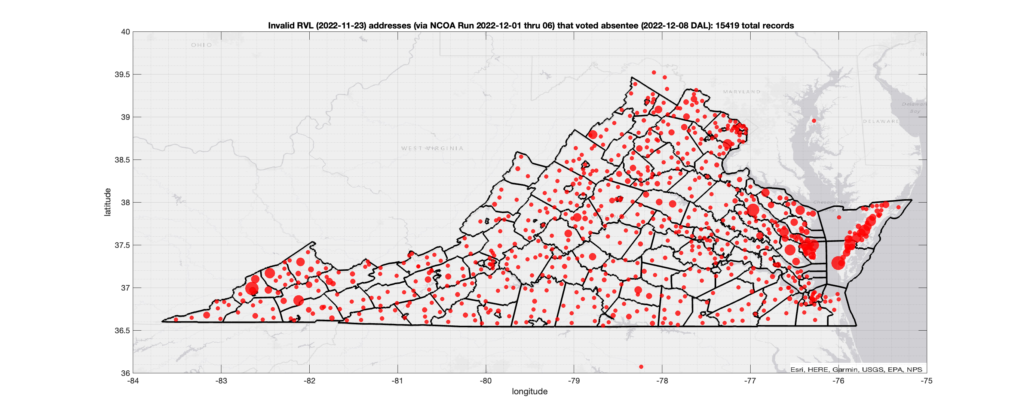
Invalid OR Vacant Addresses:
There were 17,244 records across the state with registered addresses that have been flagged as “Invalid” or “Vacant” Addresses by the NCOA check and also had an Early In-Person, Mail-In, FWAB or Provisional ballot cast in the VA 2022 General Election. Of those records, 14,083 were Early In-Person and 3,053 were Mail-In. The geographic distribution of the addresses (based on the ZIP+4), as reported by the NCOA service, is shown below, with the size of the marker proportional to the total number of counts at that ZIP+4 location.

Record of Moves Out-of-State:
There were 793 records that had records of NCOA moves to valid out-of-state addresses before 2022-08 that also had an Early In-Person, Mail-In, FWAB or Provisional ballot cast in the VA 2022 General Election. Of those records, 338 were Early In-Person and 454 were Mail-In. The geographic distribution of the addresses (based on the ZIP+4), as reported by the NCOA service, is shown below, with the size of the marker proportional to the total number of counts at that ZIP+4 location.
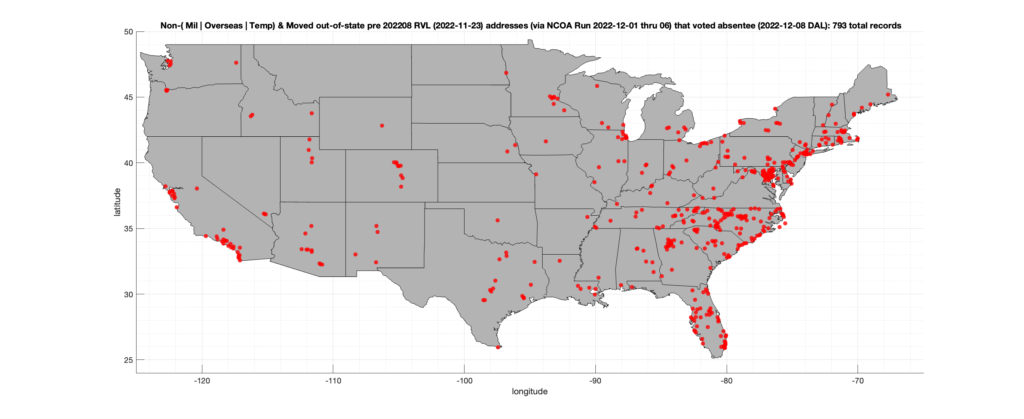
Results By District:
This section was added 2022-12-15, per multiple requests for by-district breakouts.
District 01:
Invalid Addresses:
There were 3,222 records with registered addresses that have been flagged as “Invalid” Addresses by the NCOA check and also had an Early In-Person, Mail-In, FWAB or Provisional ballot cast in the VA 2022 General Election in District 01. Of those records, 2,841 were Early In-Person and 364 were Mail-In. The geographic distribution of the addresses (based on the ZIP+4), as reported by the NCOA service, is shown below, with the size of the marker proportional to the total number of counts at that ZIP+4 location.
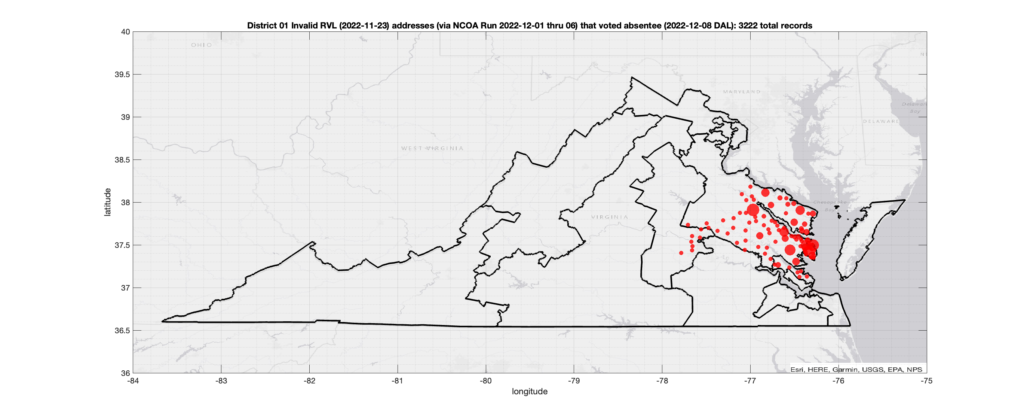
Invalid OR Vacant Addresses:
There were 3,310 records with registered addresses that have been flagged as “Invalid” or “Vacant” Addresses by the NCOA check and also had an Early In-Person, Mail-In, FWAB or Provisional ballot cast in the VA 2022 General Election in District 01. Of those records, 2,909 were Early In-Person and 384 were Mail-In. The geographic distribution of the addresses (based on the ZIP+4), as reported by the NCOA service, is shown below, with the size of the marker proportional to the total number of counts at that ZIP+4 location.

District 02:
Invalid Addresses:
There were 2,552 records with registered addresses that have been flagged as “Invalid” Addresses by the NCOA check and also had an Early In-Person, Mail-In, FWAB or Provisional ballot cast in the VA 2022 General Election in District 02. Of those records, 2,185 were Early In-Person and 353 were Mail-In. The geographic distribution of the addresses (based on the ZIP+4), as reported by the NCOA service, is shown below, with the size of the marker proportional to the total number of counts at that ZIP+4 location.

Invalid OR Vacant Addresses:
There were 2,763 records with registered addresses that have been flagged as “Invalid” or “Vacant” Addresses by the NCOA check and also had an Early In-Person, Mail-In, FWAB or Provisional ballot cast in the VA 2022 General Election in District 02. Of those records, 2,346 were Early In-Person and 400 were Mail-In. The geographic distribution of the addresses (based on the ZIP+4), as reported by the NCOA service, is shown below, with the size of the marker proportional to the total number of counts at that ZIP+4 location.
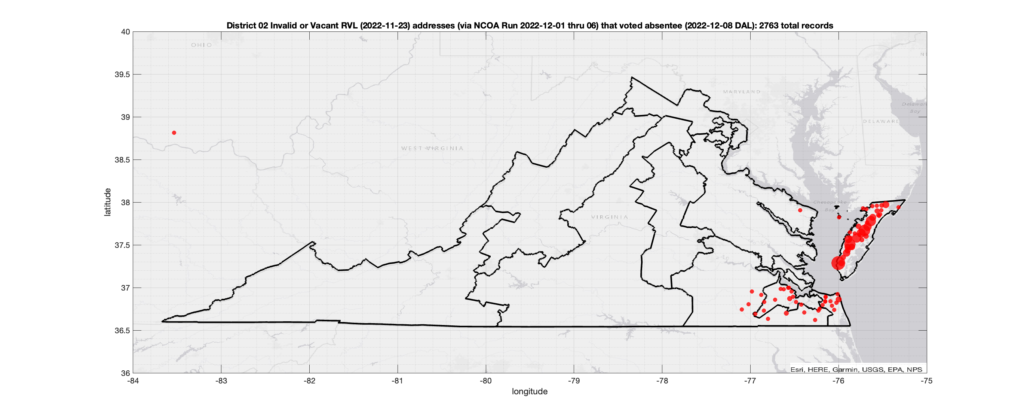
District 03:
Invalid Addresses:
There were 137 records with registered addresses that have been flagged as “Invalid” Addresses by the NCOA check and also had an Early In-Person, Mail-In, FWAB or Provisional ballot cast in the VA 2022 General Election in District 03. Of those records, 97 were Early In-Person and 34 were Mail-In. The geographic distribution of the addresses (based on the ZIP+4), as reported by the NCOA service, is shown below, with the size of the marker proportional to the total number of counts at that ZIP+4 location.
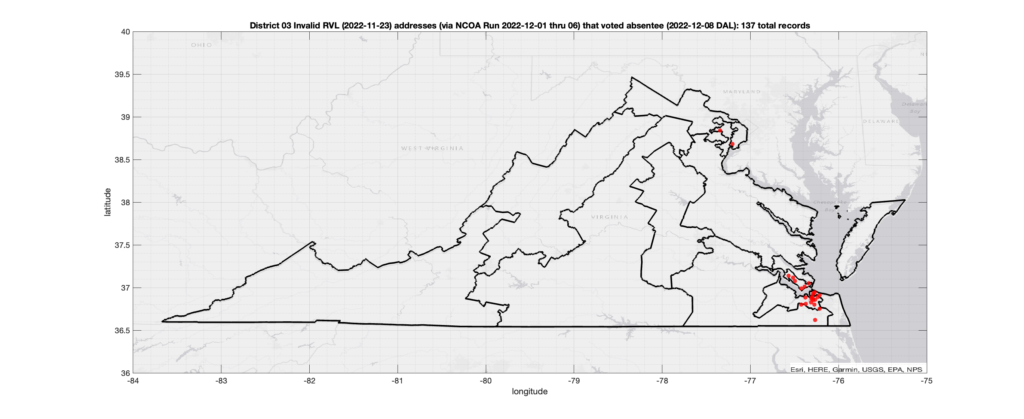
Invalid OR Vacant Addresses:
There were 412 records with registered addresses that have been flagged as “Invalid” or “Vacant” Addresses by the NCOA check and also had an Early In-Person, Mail-In, FWAB or Provisional ballot cast in the VA 2022 General Election in District 03. Of those records, 283 were Early In-Person and 117 were Mail-In. The geographic distribution of the addresses (based on the ZIP+4), as reported by the NCOA service, is shown below, with the size of the marker proportional to the total number of counts at that ZIP+4 location.
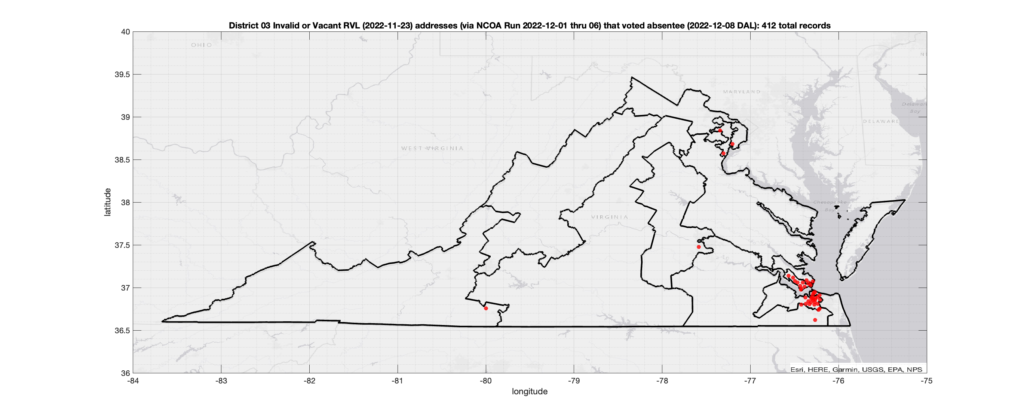
District 04:
Invalid Addresses:
There were 507 records with registered addresses that have been flagged as “Invalid” Addresses by the NCOA check and also had an Early In-Person, Mail-In, FWAB or Provisional ballot cast in the VA 2022 General Election in District 04. Of those records, 423 were Early In-Person and 78 were Mail-In. The geographic distribution of the addresses (based on the ZIP+4), as reported by the NCOA service, is shown below, with the size of the marker proportional to the total number of counts at that ZIP+4 location.
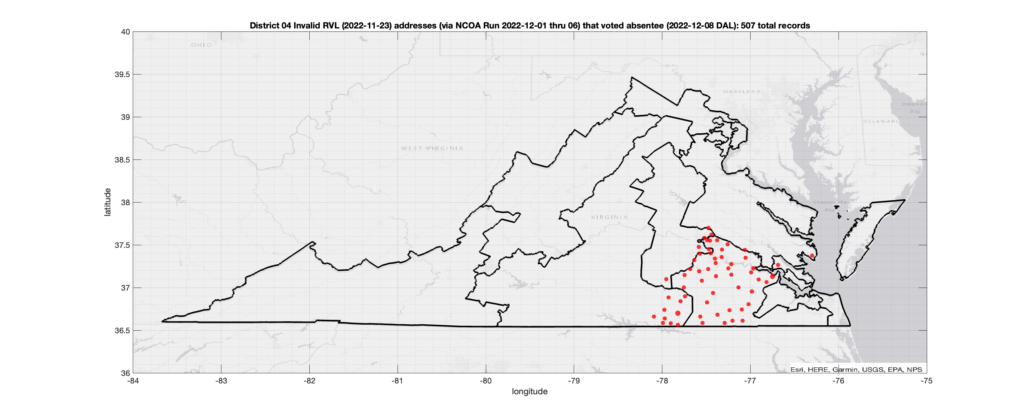
Invalid OR Vacant Addresses:
There were 695 records with registered addresses that have been flagged as “Invalid” or “Vacant” Addresses by the NCOA check and also had an Early In-Person, Mail-In, FWAB or Provisional ballot cast in the VA 2022 General Election in District 04. Of those records, 567 were Early In-Person and 121 were Mail-In. The geographic distribution of the addresses (based on the ZIP+4), as reported by the NCOA service, is shown below, with the size of the marker proportional to the total number of counts at that ZIP+4 location.
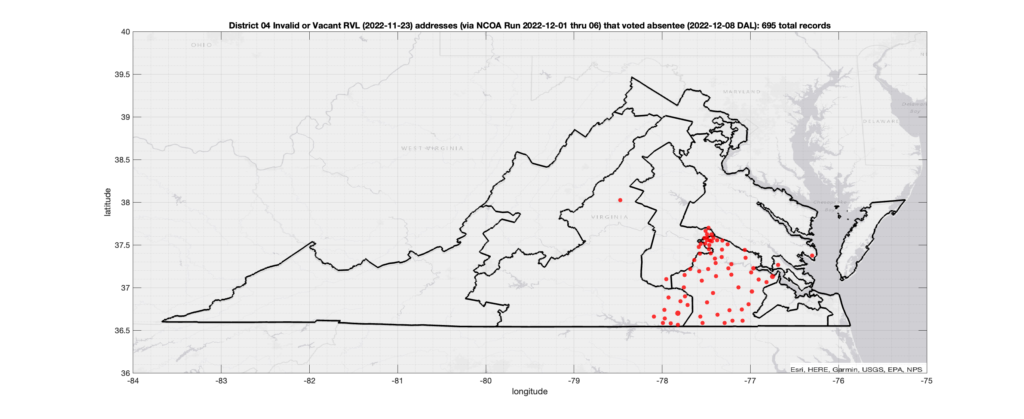
District 05:
Invalid Addresses:
There were 2,093 records with registered addresses that have been flagged as “Invalid” Addresses by the NCOA check and also had an Early In-Person, Mail-In, FWAB or Provisional ballot cast in the VA 2022 General Election in District 05. Of those records, 1,738 were Early In-Person and 348 were Mail-In. The geographic distribution of the addresses (based on the ZIP+4), as reported by the NCOA service, is shown below, with the size of the marker proportional to the total number of counts at that ZIP+4 location.
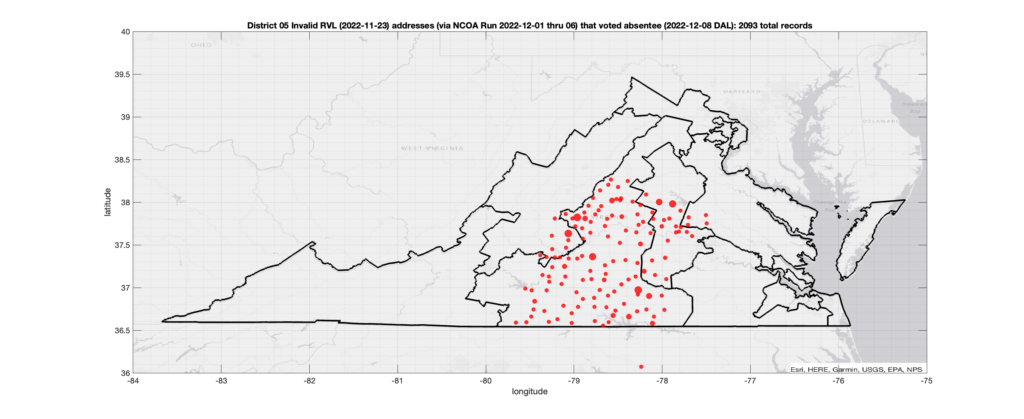
Invalid OR Vacant Addresses:
There were 2,264 records with registered addresses that have been flagged as “Invalid” or “Vacant” Addresses by the NCOA check and also had an Early In-Person, Mail-In, FWAB or Provisional ballot cast in the VA 2022 General Election in District 05. Of those records, 1,860 were Early In-Person and 395 were Mail-In. The geographic distribution of the addresses (based on the ZIP+4), as reported by the NCOA service, is shown below, with the size of the marker proportional to the total number of counts at that ZIP+4 location.
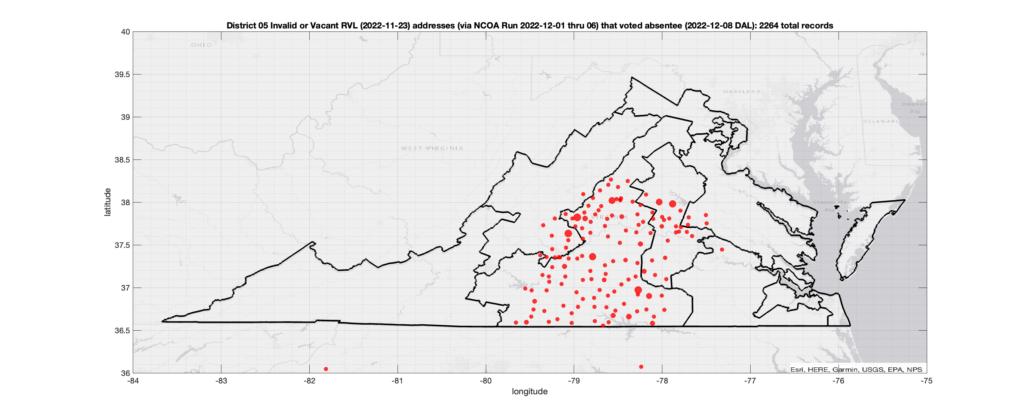
District 06:
Invalid Addresses:
There were 1,214 records with registered addresses that have been flagged as “Invalid” Addresses by the NCOA check and also had an Early In-Person, Mail-In, FWAB or Provisional ballot cast in the VA 2022 General Election in District 06. Of those records, 990 were Early In-Person and 212 were Mail-In. The geographic distribution of the addresses (based on the ZIP+4), as reported by the NCOA service, is shown below, with the size of the marker proportional to the total number of counts at that ZIP+4 location.
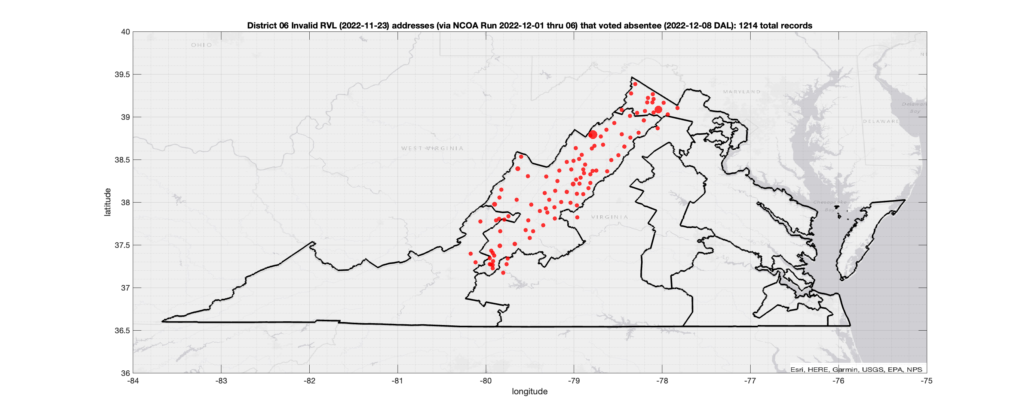
Invalid OR Vacant Addresses:
There were 1,390 records with registered addresses that have been flagged as “Invalid” or “Vacant” Addresses by the NCOA check and also had an Early In-Person, Mail-In, FWAB or Provisional ballot cast in the VA 2022 General Election in District 06. Of those records, 1,129 were Early In-Person and 247 were Mail-In. The geographic distribution of the addresses (based on the ZIP+4), as reported by the NCOA service, is shown below, with the size of the marker proportional to the total number of counts at that ZIP+4 location.
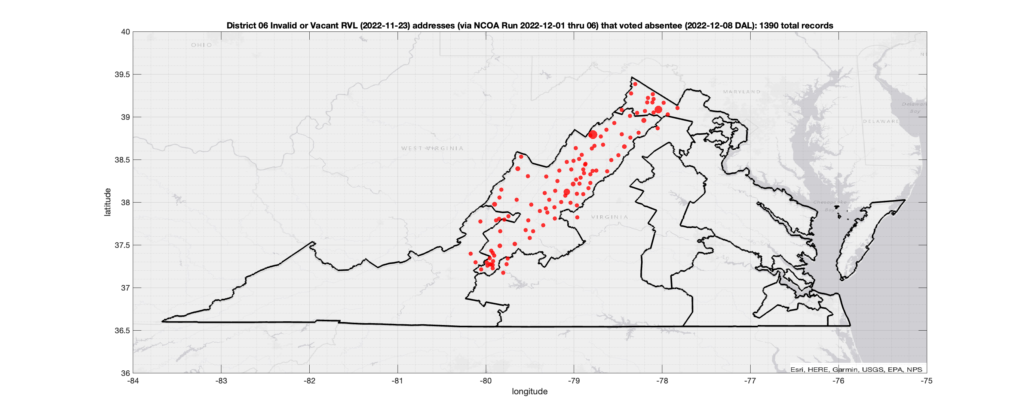
District 07:
Invalid Addresses:
There were 1,042 records with registered addresses that have been flagged as “Invalid” Addresses by the NCOA check and also had an Early In-Person, Mail-In, FWAB or Provisional ballot cast in the VA 2022 General Election in District 07. Of those records, 868 were Early In-Person and 167 were Mail-In. The geographic distribution of the addresses (based on the ZIP+4), as reported by the NCOA service, is shown below, with the size of the marker proportional to the total number of counts at that ZIP+4 location.

Invalid OR Vacant Addresses:
There were 1,139 records with registered addresses that have been flagged as “Invalid” or “Vacant” Addresses by the NCOA check and also had an Early In-Person, Mail-In, FWAB or Provisional ballot cast in the VA 2022 General Election in District 07. Of those records, 946 were Early In-Person and 183 were Mail-In. The geographic distribution of the addresses (based on the ZIP+4), as reported by the NCOA service, is shown below, with the size of the marker proportional to the total number of counts at that ZIP+4 location.
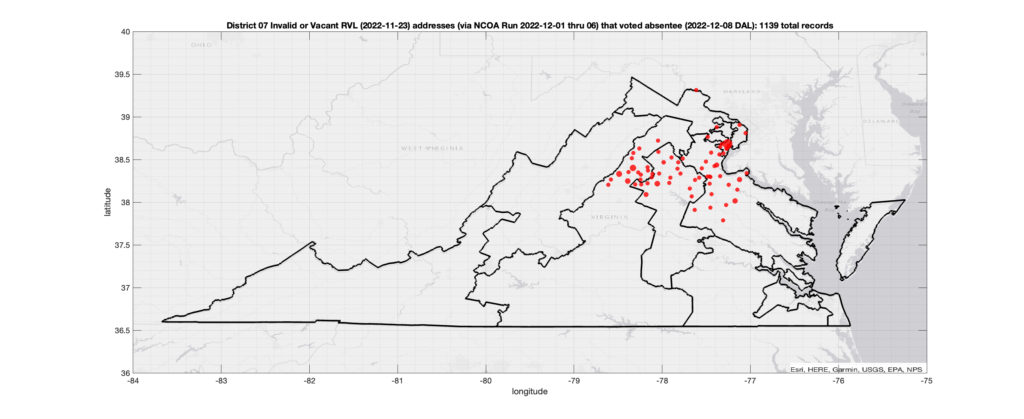
District 08:
Invalid Addresses:
There were 276 records with registered addresses that have been flagged as “Invalid” Addresses by the NCOA check and also had an Early In-Person, Mail-In, FWAB or Provisional ballot cast in the VA 2022 General Election in District 08. Of those records, 148 were Early In-Person and 125 were Mail-In. The geographic distribution of the addresses (based on the ZIP+4), as reported by the NCOA service, is shown below, with the size of the marker proportional to the total number of counts at that ZIP+4 location.

Invalid OR Vacant Addresses:
There were 517 records with registered addresses that have been flagged as “Invalid” or “Vacant” Addresses by the NCOA check and also had an Early In-Person, Mail-In, FWAB or Provisional ballot cast in the VA 2022 General Election in District 08. Of those records, 300 were Early In-Person and 212 were Mail-In. The geographic distribution of the addresses (based on the ZIP+4), as reported by the NCOA service, is shown below, with the size of the marker proportional to the total number of counts at that ZIP+4 location.
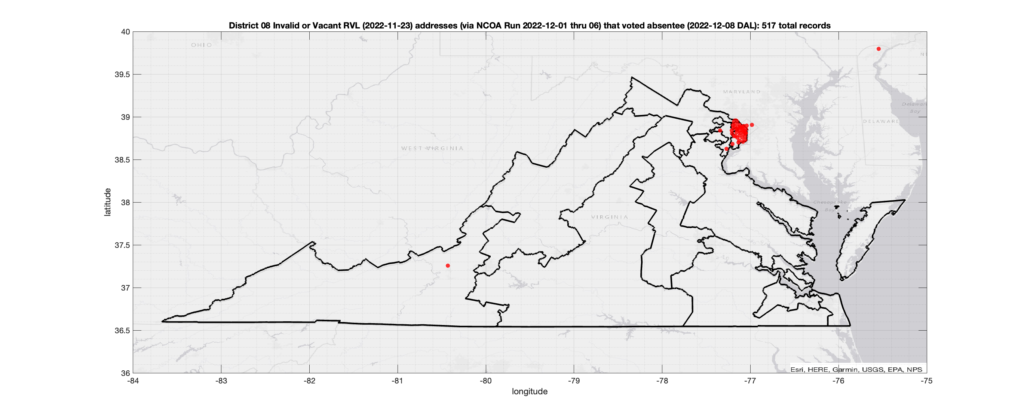
District 09:
Invalid Addresses:
There were 3,247 records with registered addresses that have been flagged as “Invalid” Addresses by the NCOA check and also had an Early In-Person, Mail-In, FWAB or Provisional ballot cast in the VA 2022 General Election in District 09. Of those records, 2,639 were Early In-Person and 597 were Mail-In. The geographic distribution of the addresses (based on the ZIP+4), as reported by the NCOA service, is shown below, with the size of the marker proportional to the total number of counts at that ZIP+4 location.
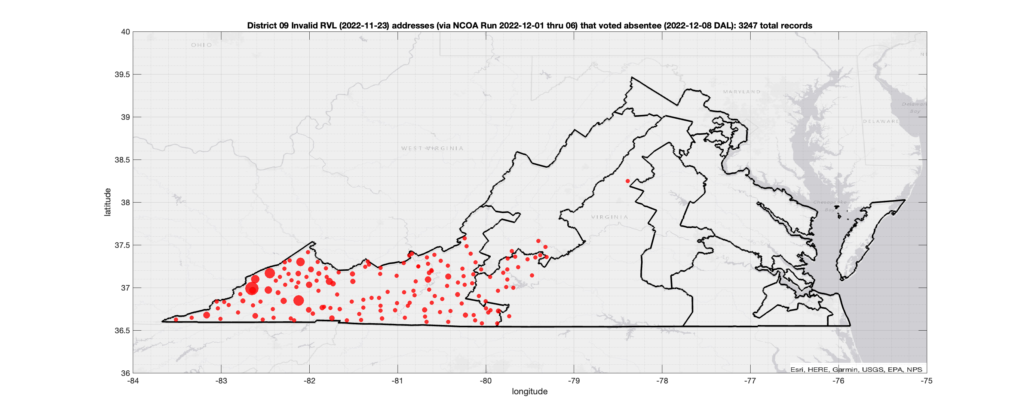
Invalid OR Vacant Addresses:
There were 3,369 records with registered addresses that have been flagged as “Invalid” or “Vacant” Addresses by the NCOA check and also had an Early In-Person, Mail-In, FWAB or Provisional ballot cast in the VA 2022 General Election in District 09. Of those records, 2,733 were Early In-Person and 624 were Mail-In. The geographic distribution of the addresses (based on the ZIP+4), as reported by the NCOA service, is shown below, with the size of the marker proportional to the total number of counts at that ZIP+4 location.
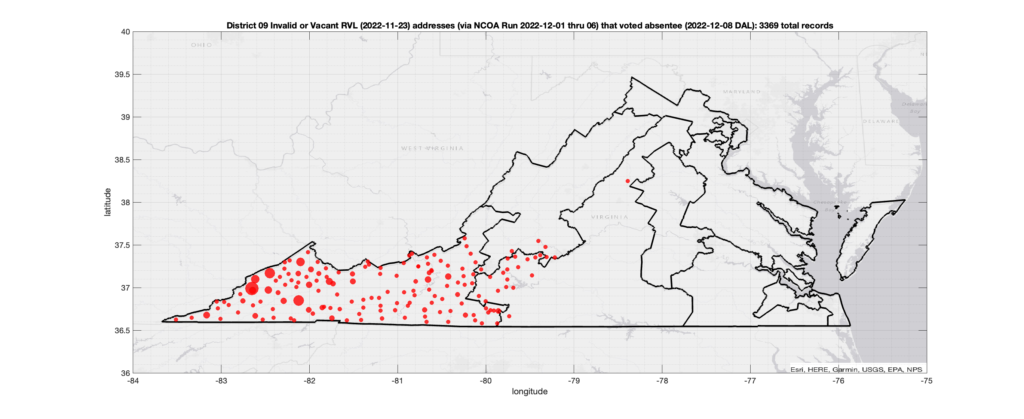
District 10:
Invalid Addresses:
There were 940 records with registered addresses that have been flagged as “Invalid” Addresses by the NCOA check and also had an Early In-Person, Mail-In, FWAB or Provisional ballot cast in the VA 2022 General Election in District 10. Of those records, 740 were Early In-Person and 198 were Mail-In. The geographic distribution of the addresses (based on the ZIP+4), as reported by the NCOA service, is shown below, with the size of the marker proportional to the total number of counts at that ZIP+4 location.
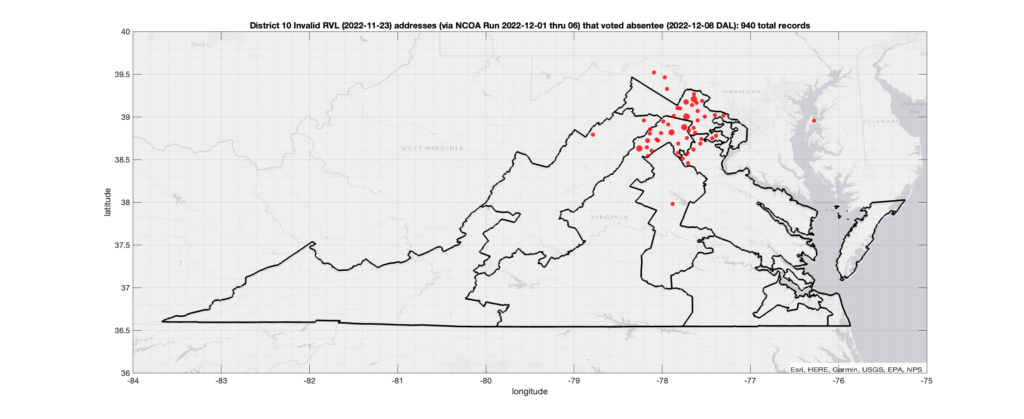
Invalid OR Vacant Addresses:
There were 992 records with registered addresses that have been flagged as “Invalid” or “Vacant” Addresses by the NCOA check and also had an Early In-Person, Mail-In, FWAB or Provisional ballot cast in the VA 2022 General Election in District 10. Of those records, 783 were Early In-Person and 207 were Mail-In. The geographic distribution of the addresses (based on the ZIP+4), as reported by the NCOA service, is shown below, with the size of the marker proportional to the total number of counts at that ZIP+4 location.

District 11:
Invalid Addresses:
There were 189 records with registered addresses that have been flagged as “Invalid” Addresses by the NCOA check and also had an Early In-Person, Mail-In, FWAB or Provisional ballot cast in the VA 2022 General Election in District 11. Of those records, 97 were Early In-Person and 90 were Mail-In. The geographic distribution of the addresses (based on the ZIP+4), as reported by the NCOA service, is shown below, with the size of the marker proportional to the total number of counts at that ZIP+4 location.
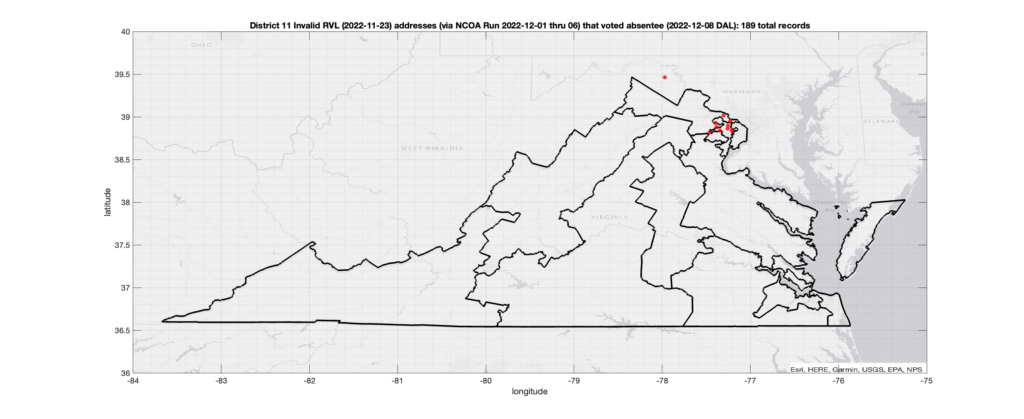
Invalid OR Vacant Addresses:
There were 393 records with registered addresses that have been flagged as “Invalid” or “Vacant” Addresses by the NCOA check and also had an Early In-Person, Mail-In, FWAB or Provisional ballot cast in the VA 2022 General Election in District 11. Of those records, 227 were Early In-Person and 163 were Mail-In. The geographic distribution of the addresses (based on the ZIP+4), as reported by the NCOA service, is shown below, with the size of the marker proportional to the total number of counts at that ZIP+4 location.

Summary Data Files by Locality:
The complete set of graphics and statistics for each locality, and each congressional district in VA can be downloaded here as a zip file. The tabulated summary results can also be downloaded in excel, csv, or numbers format:

